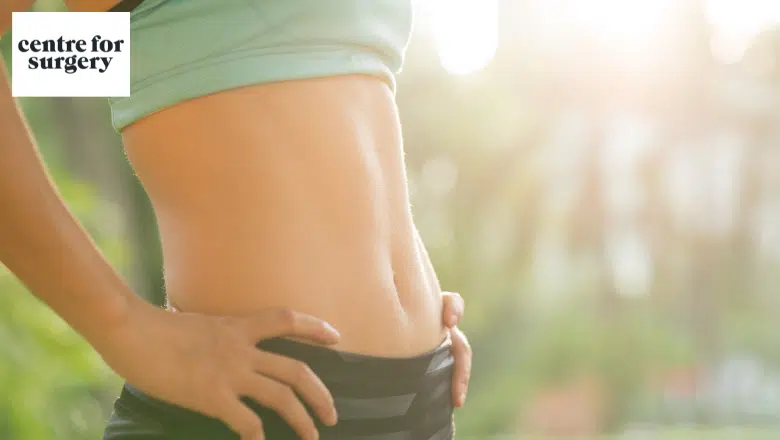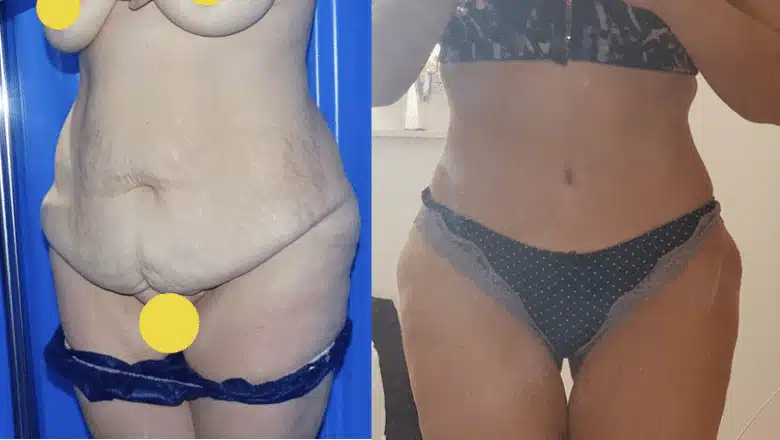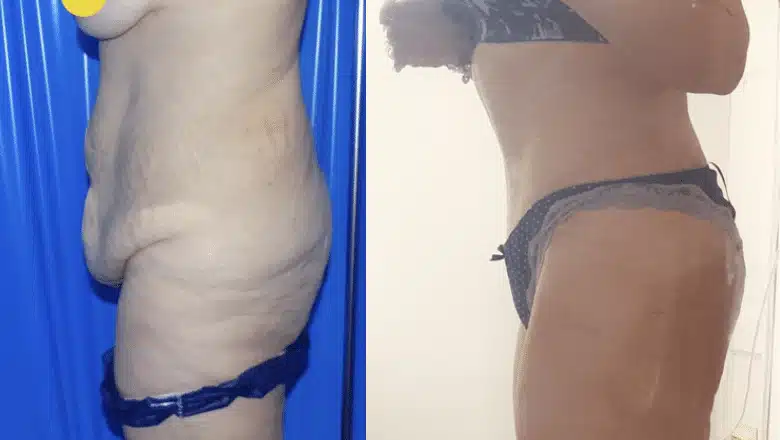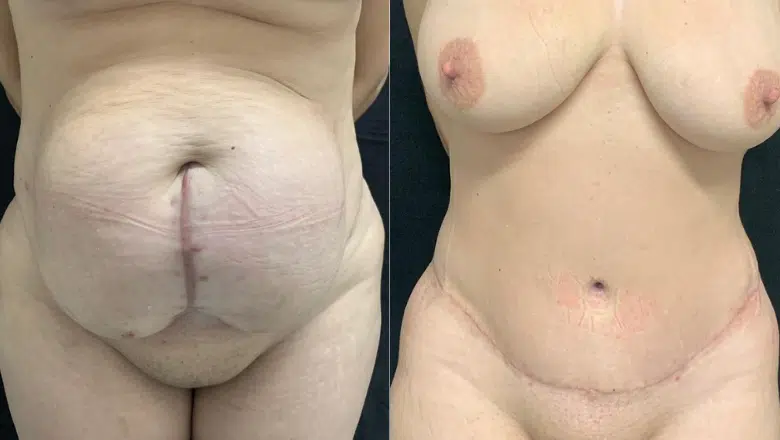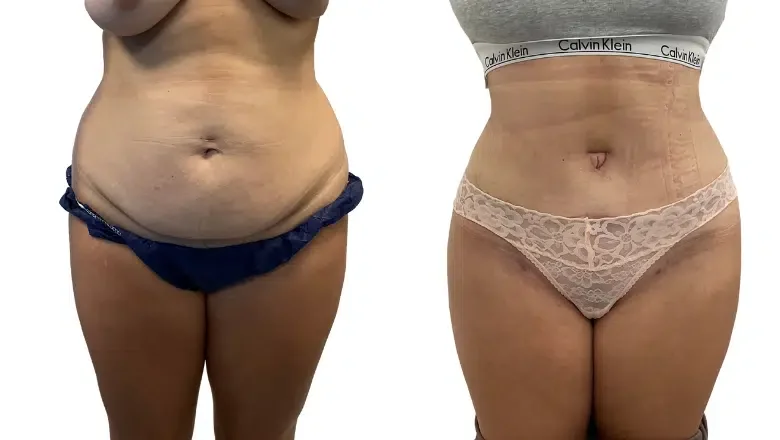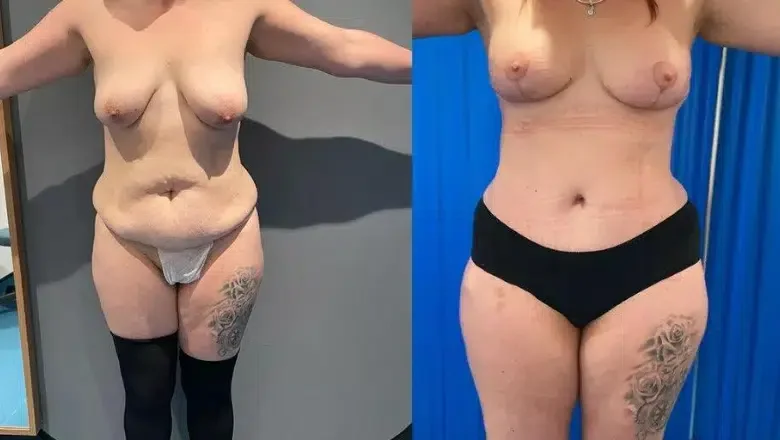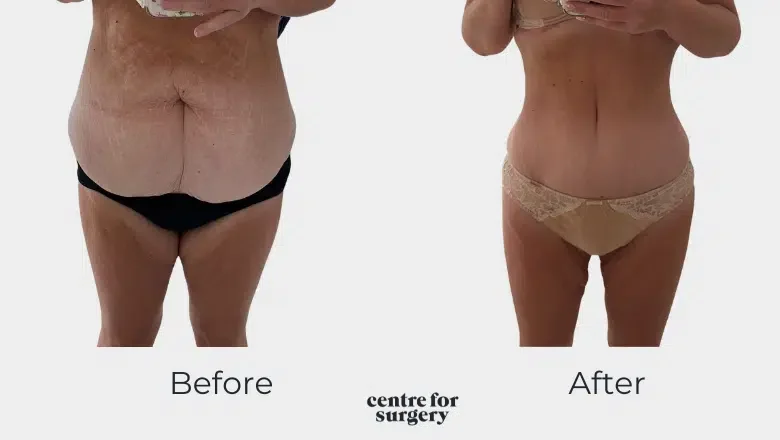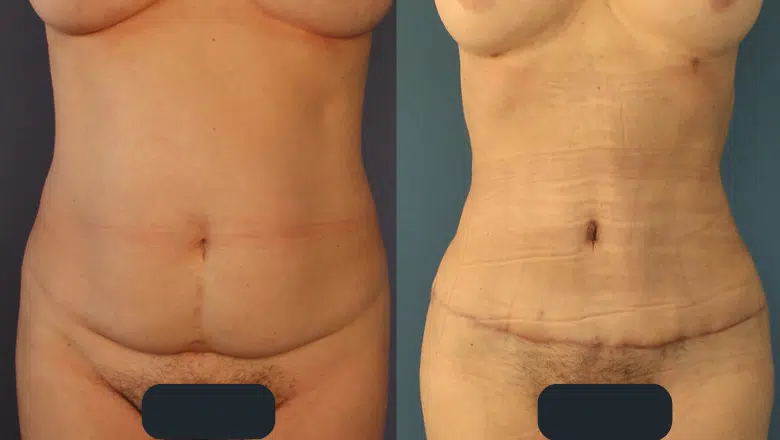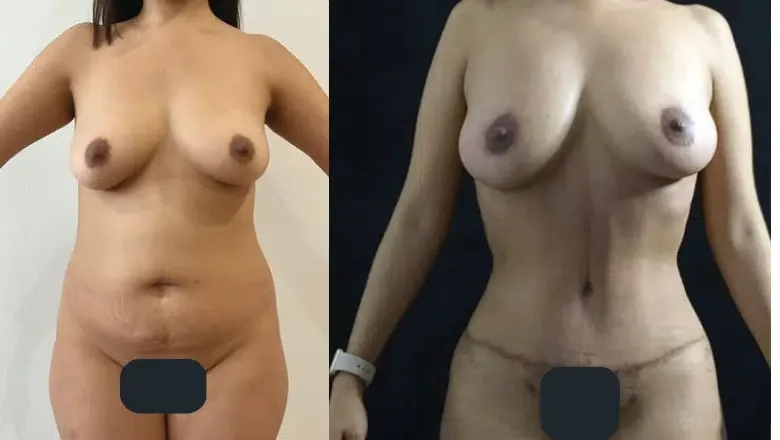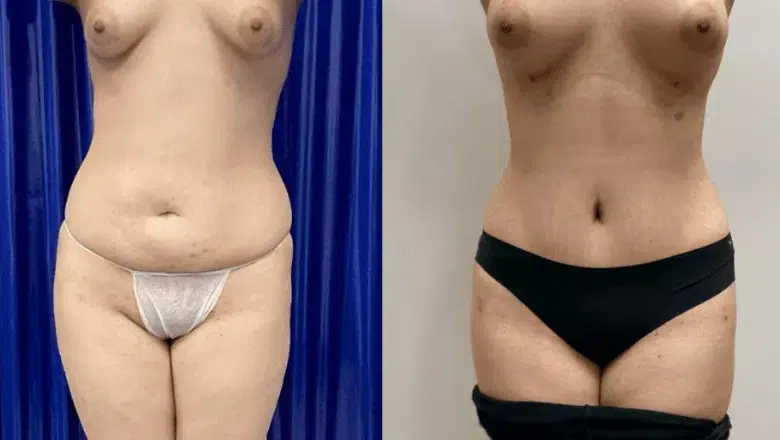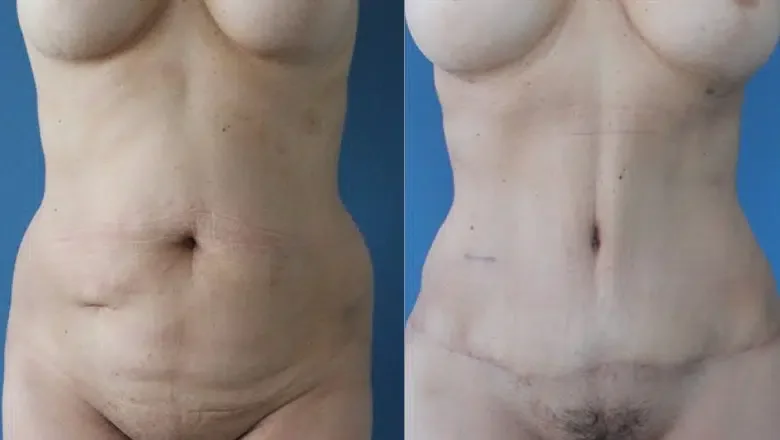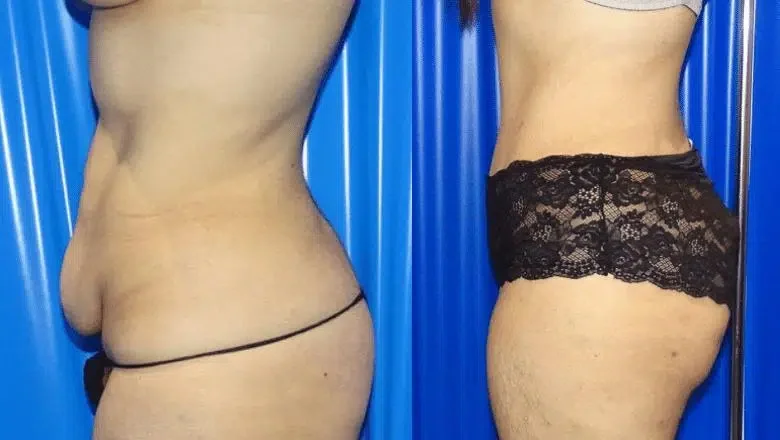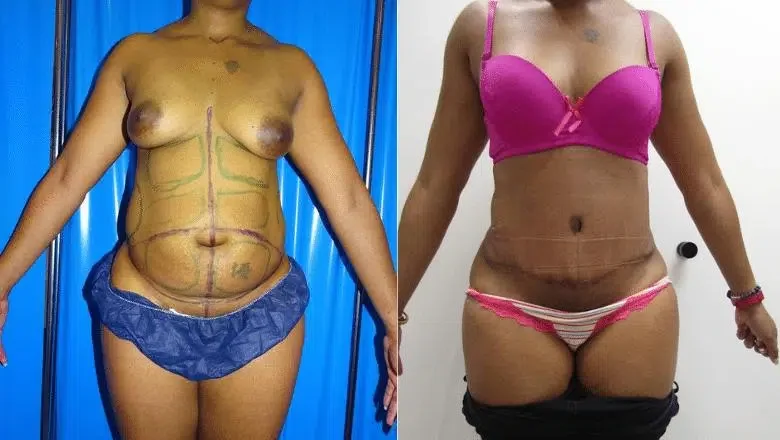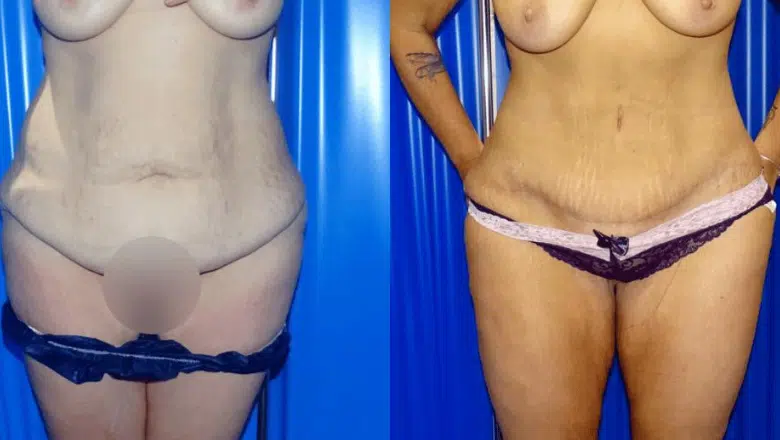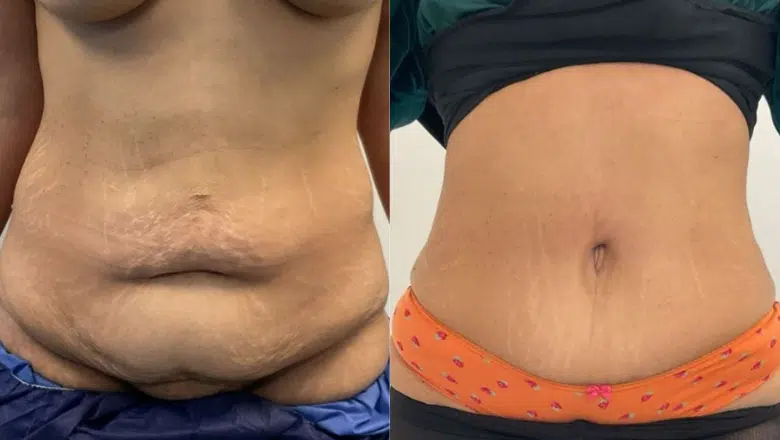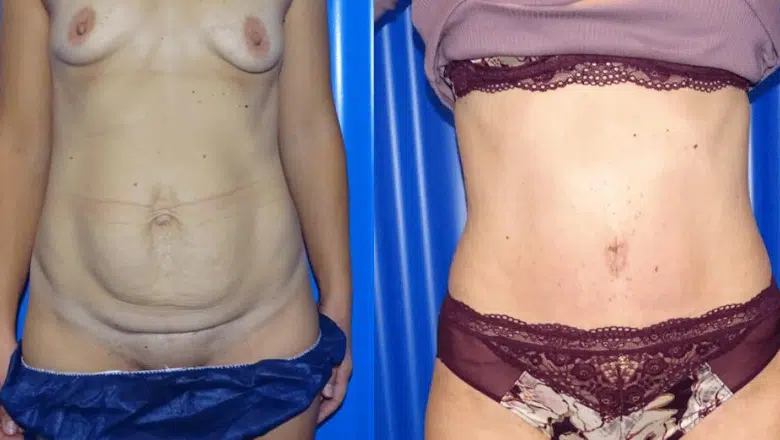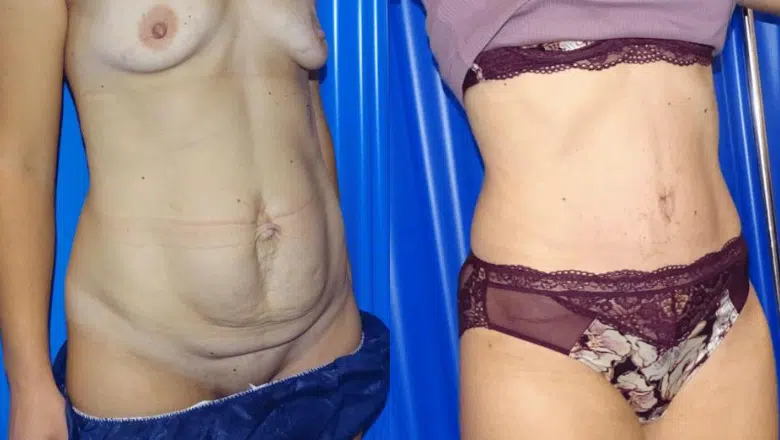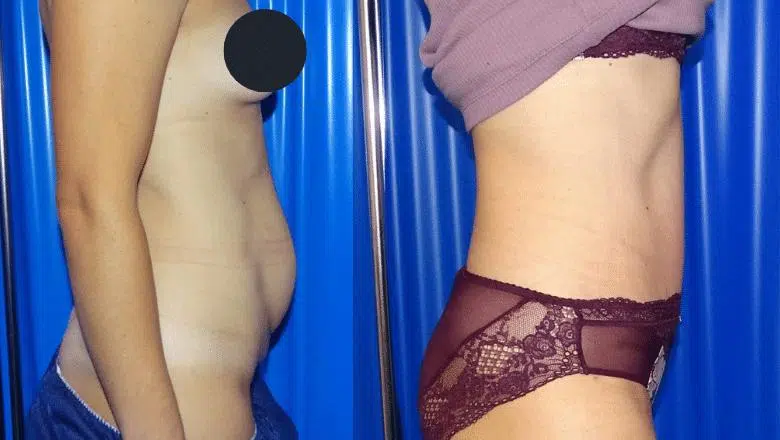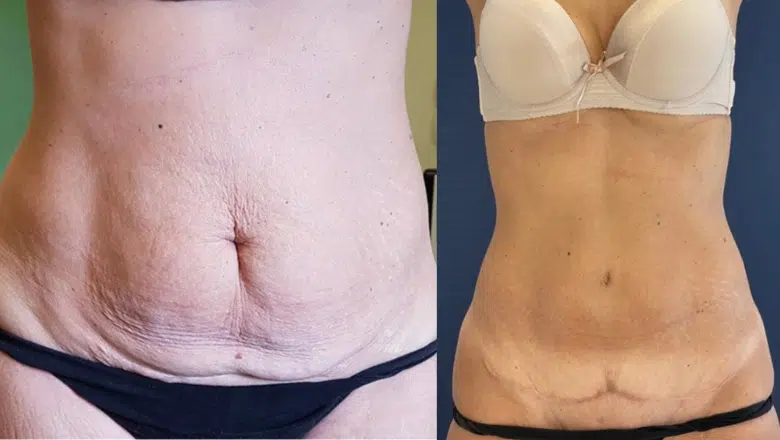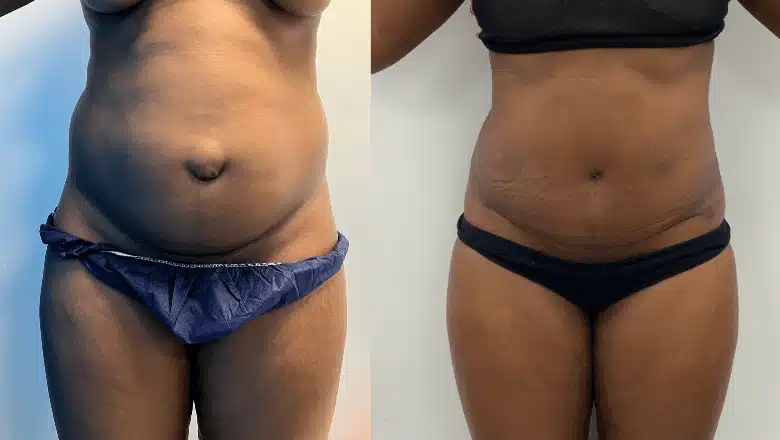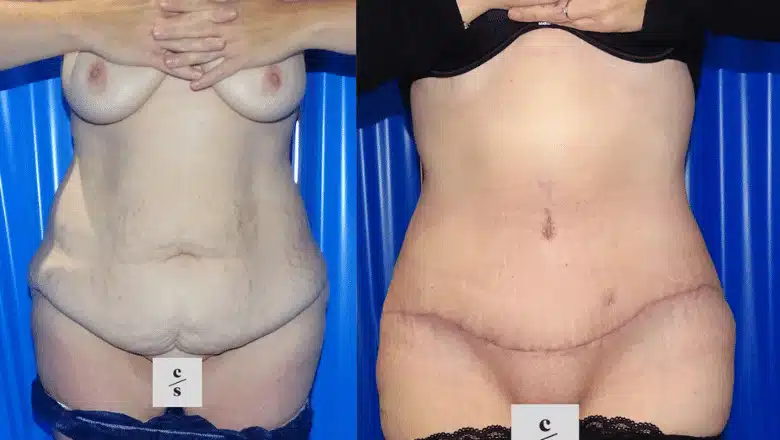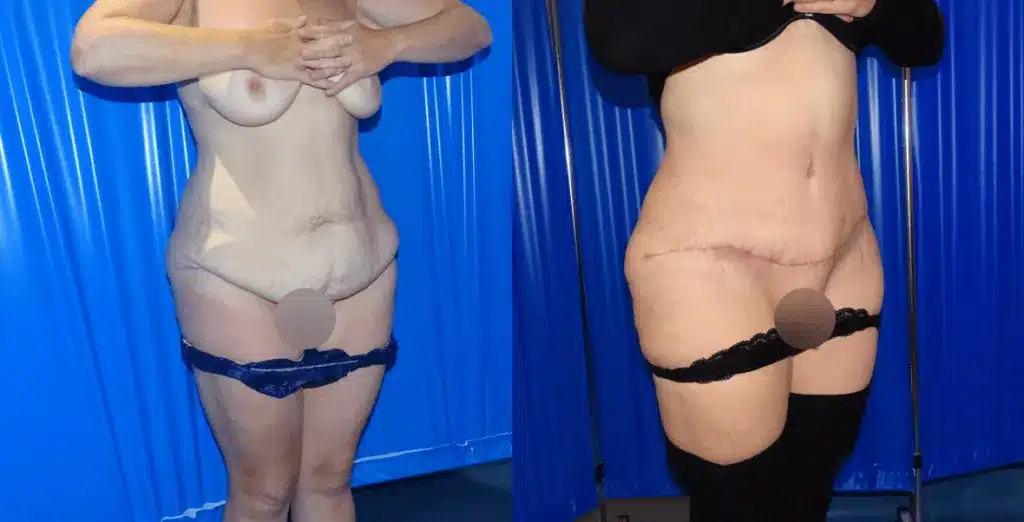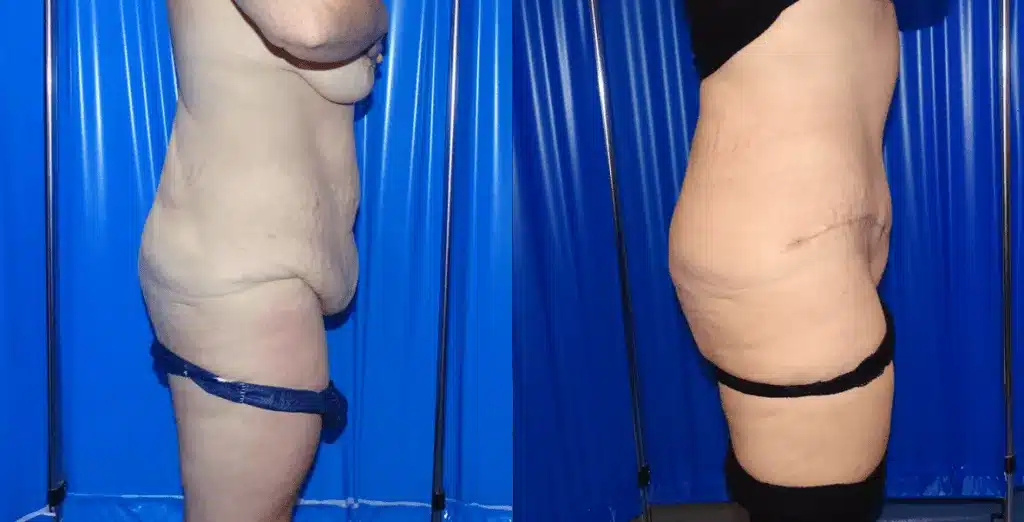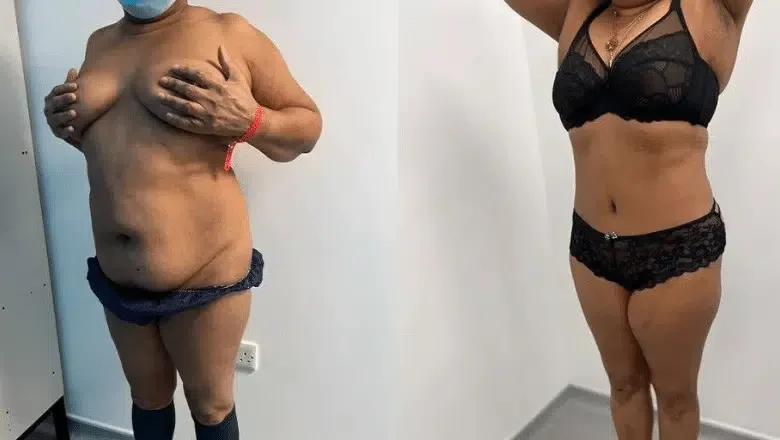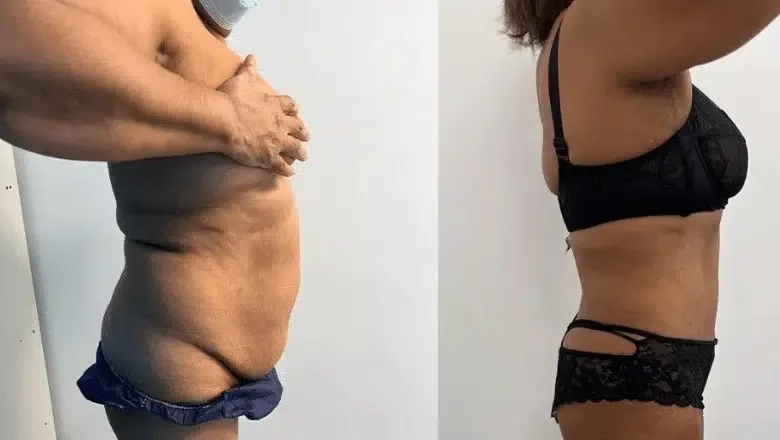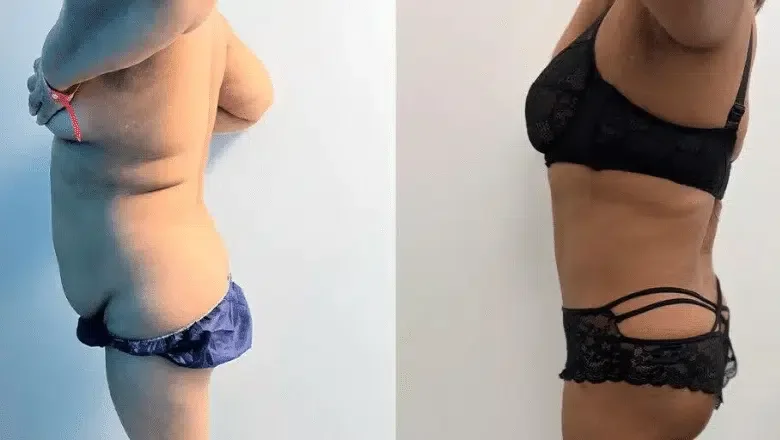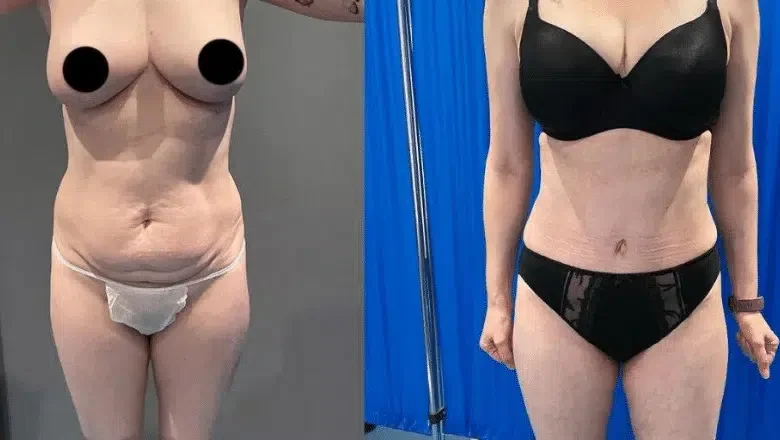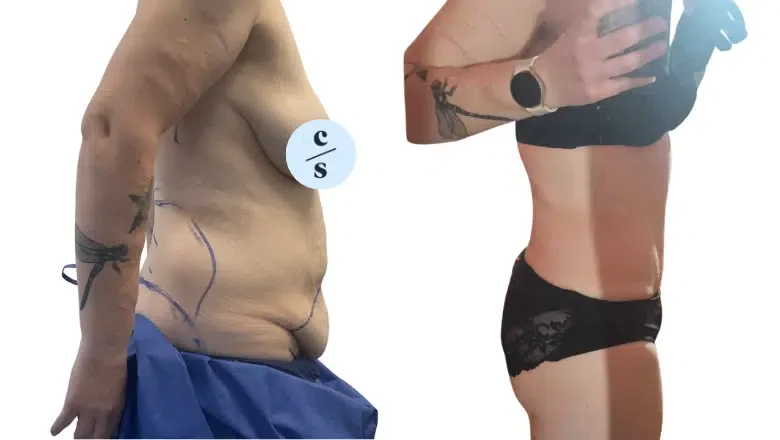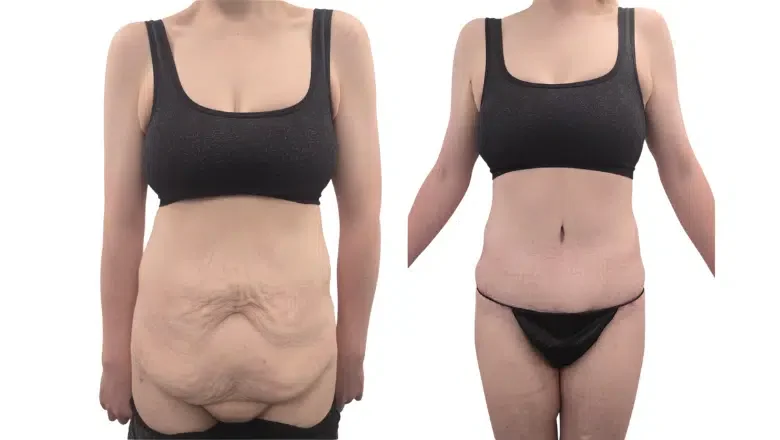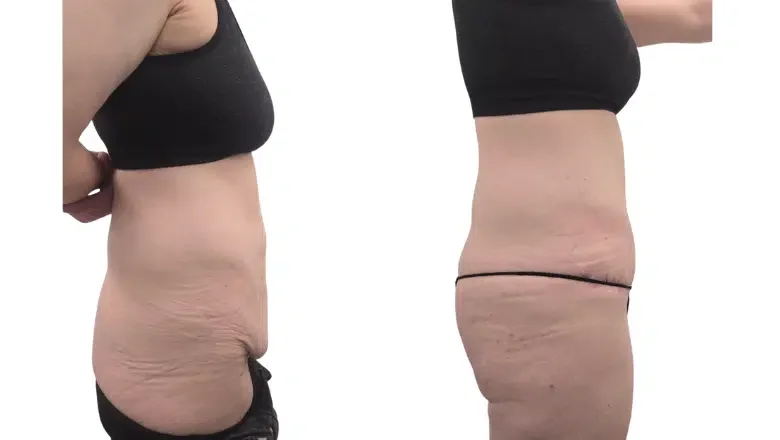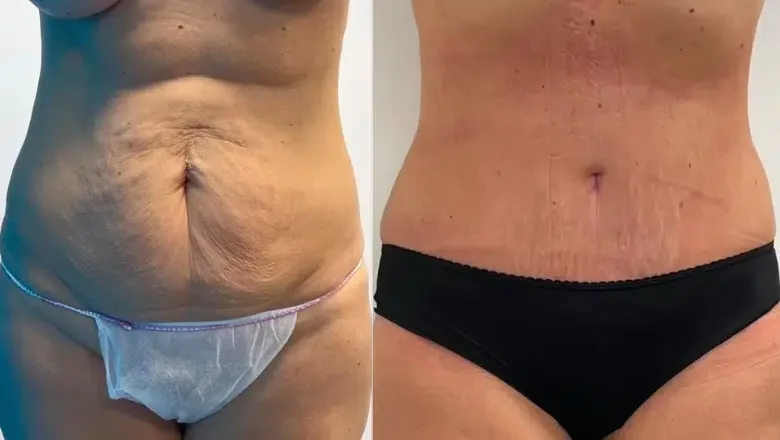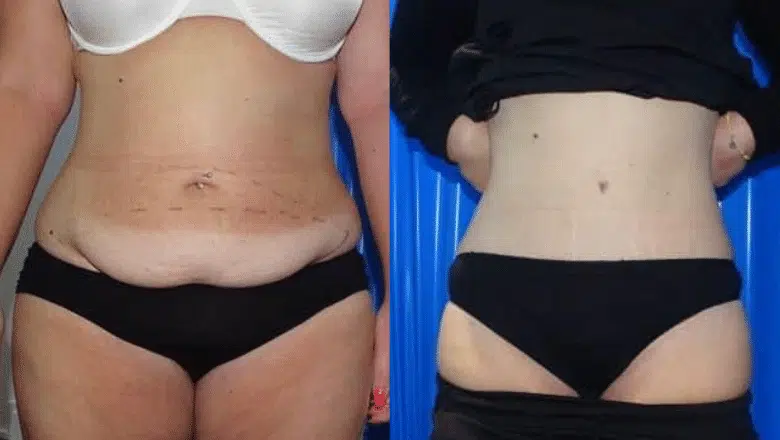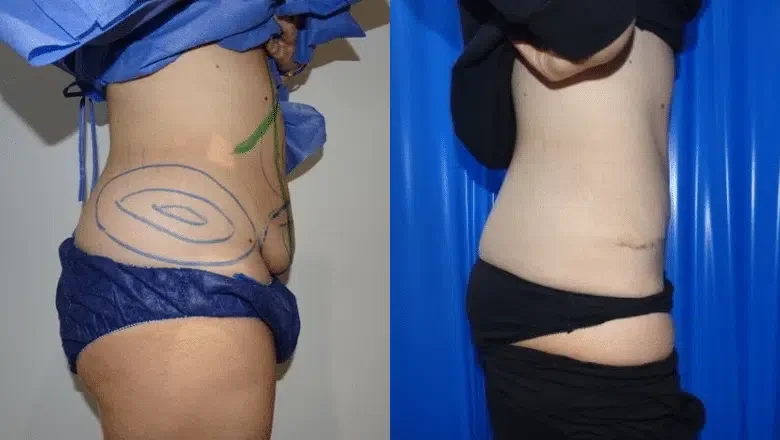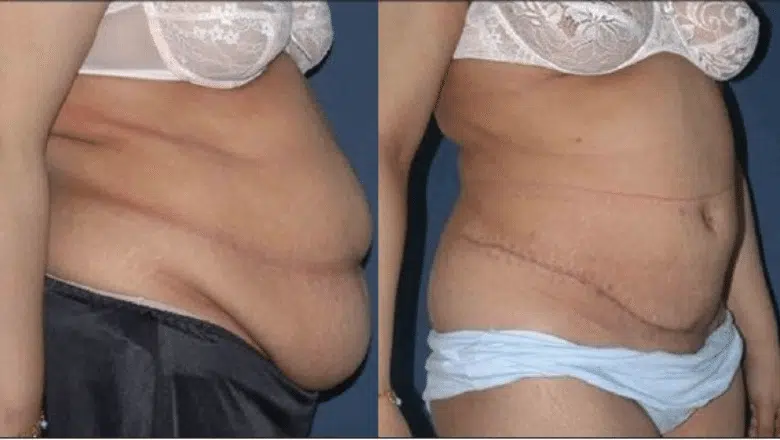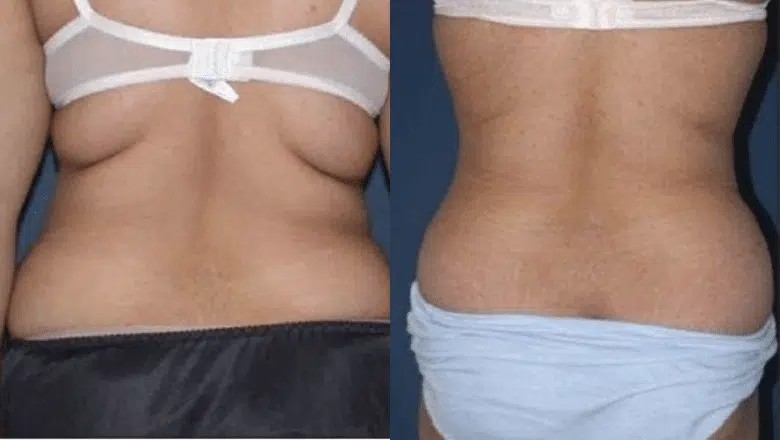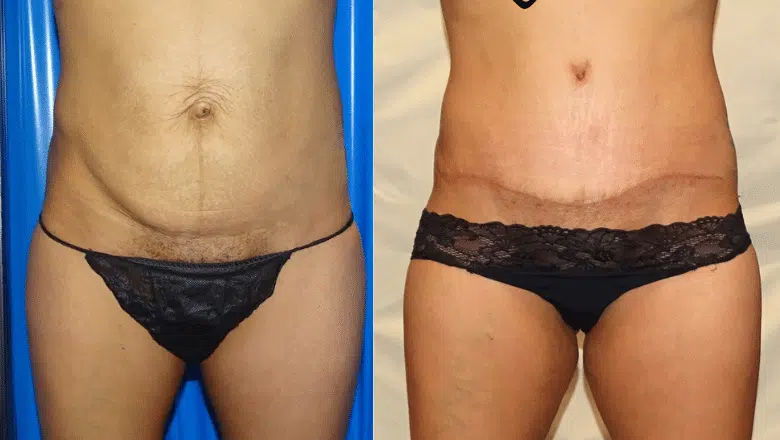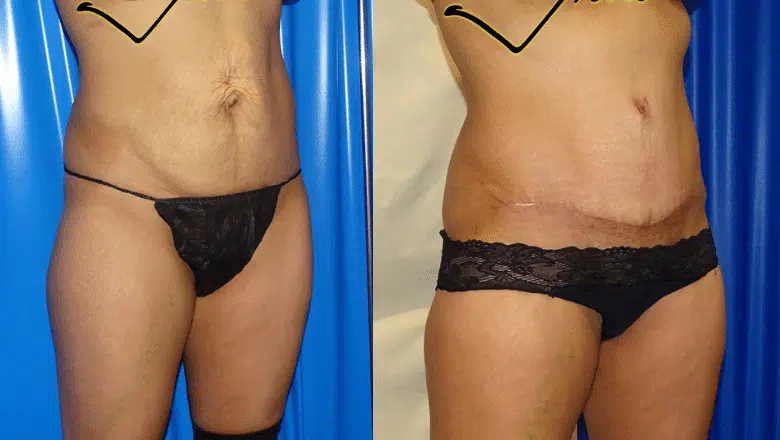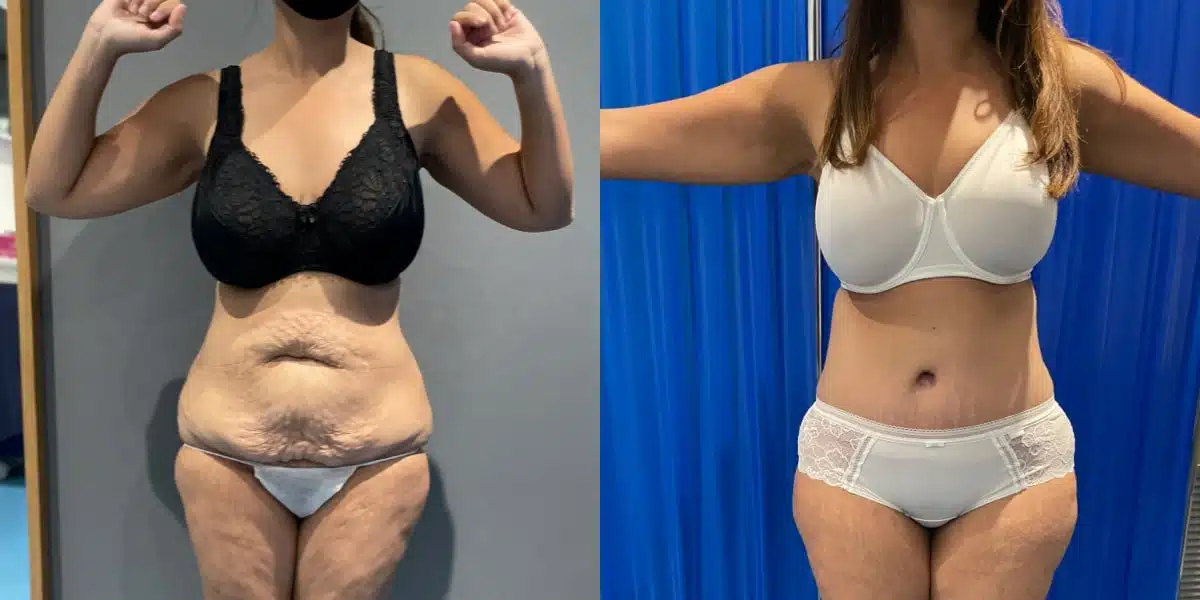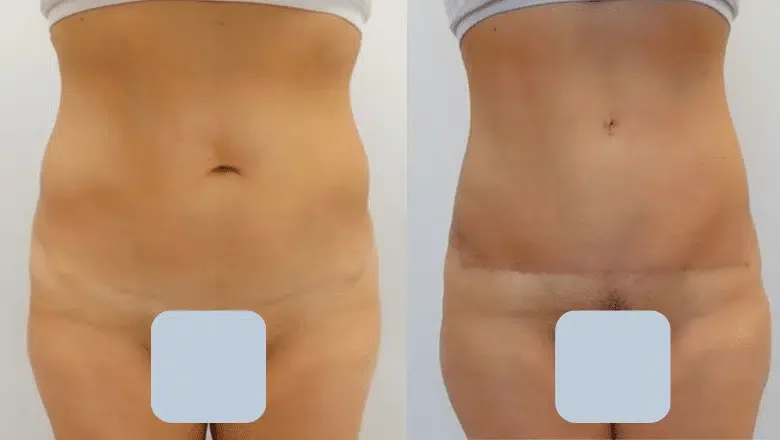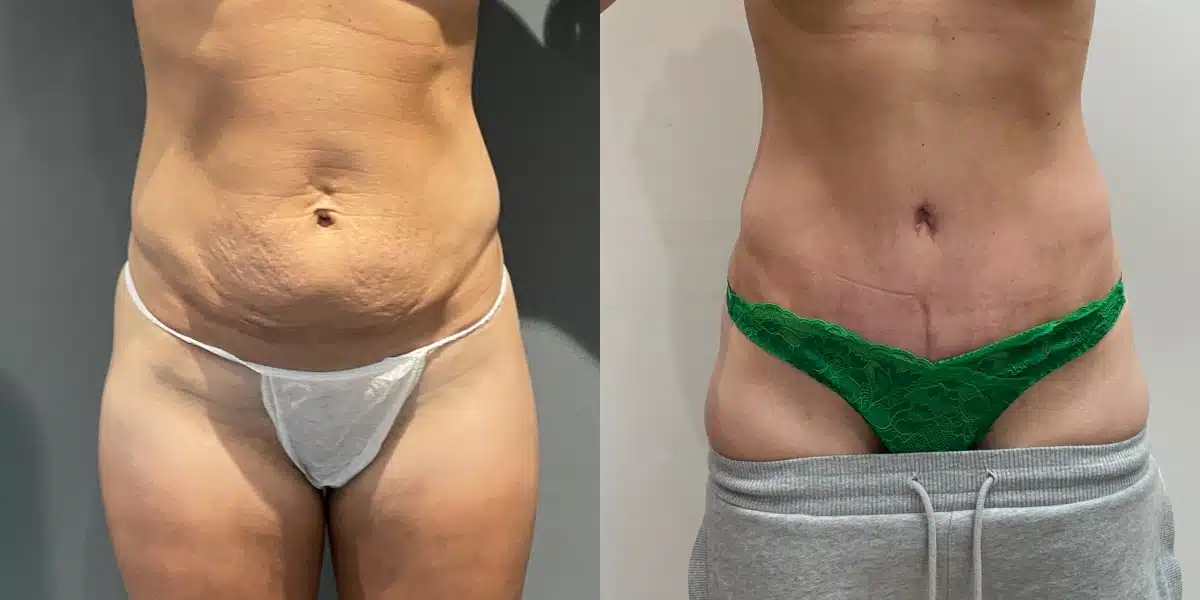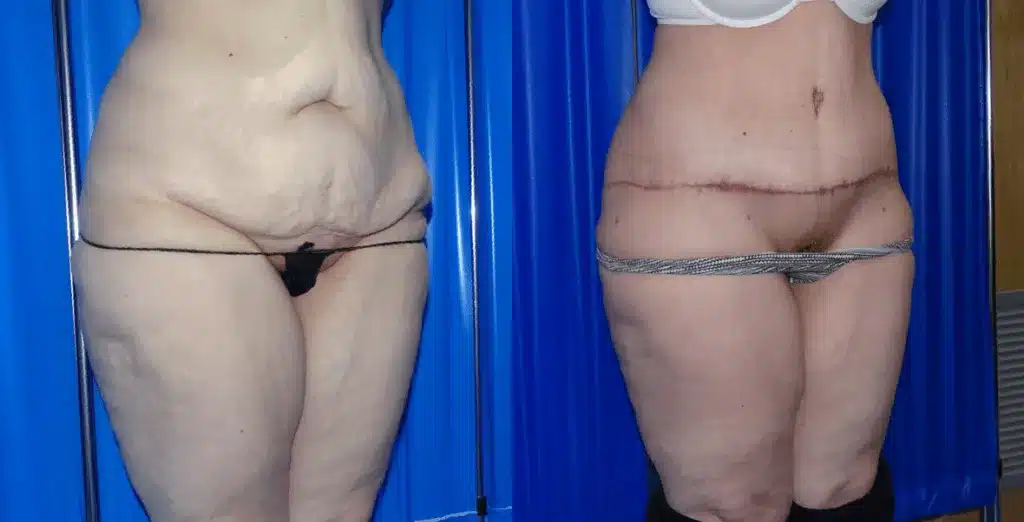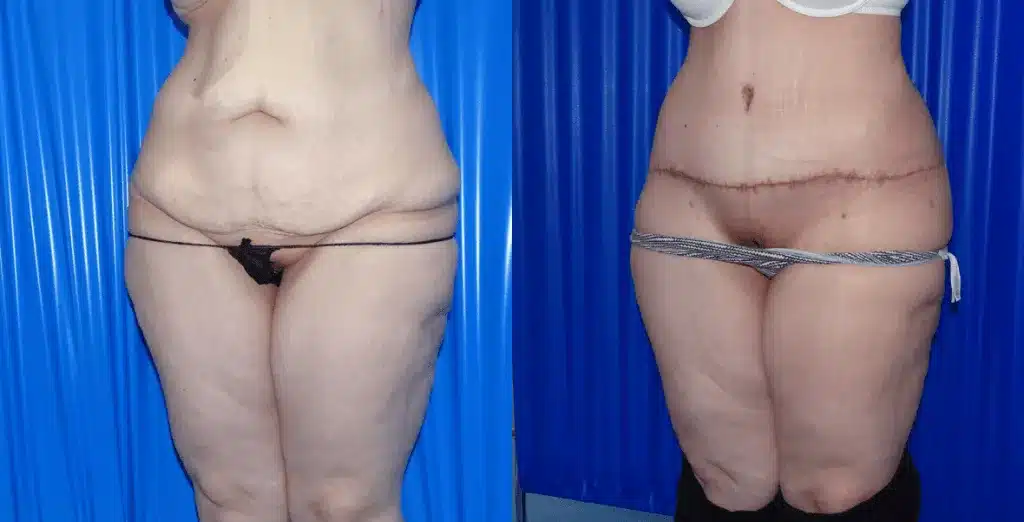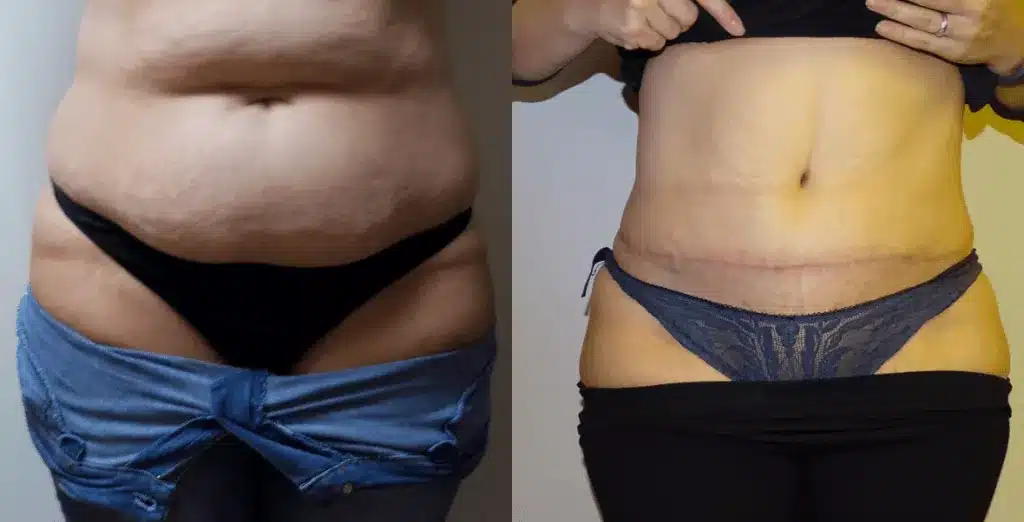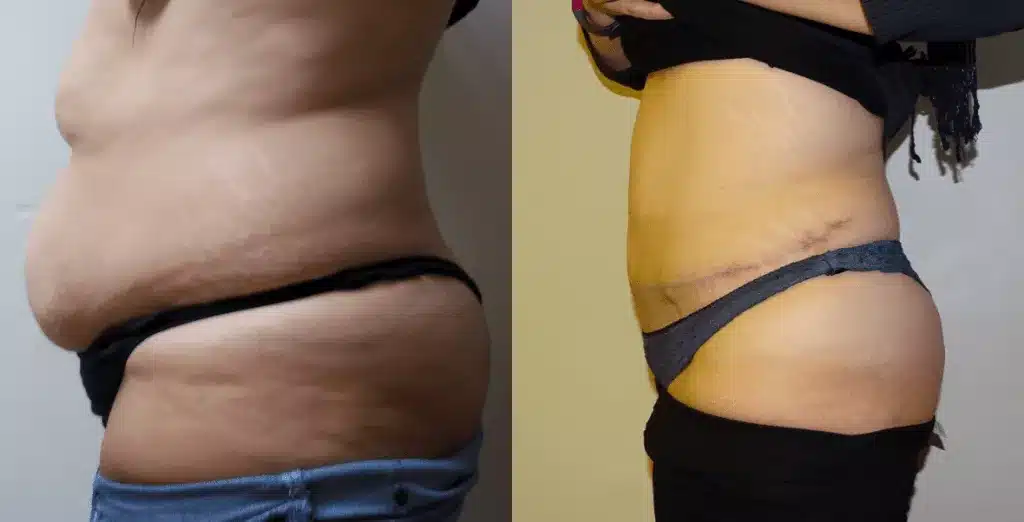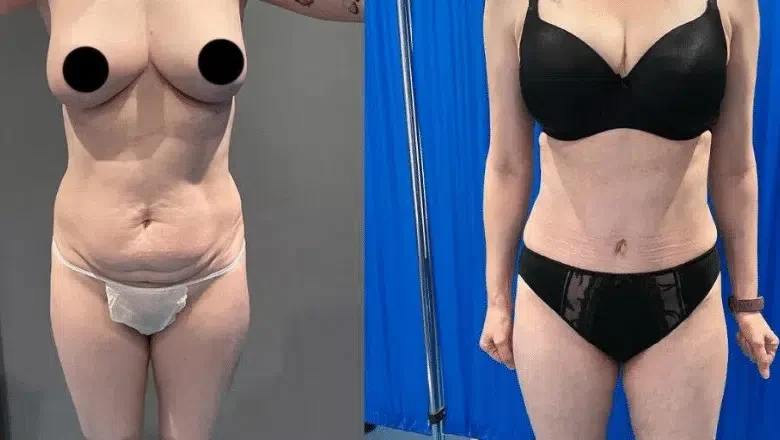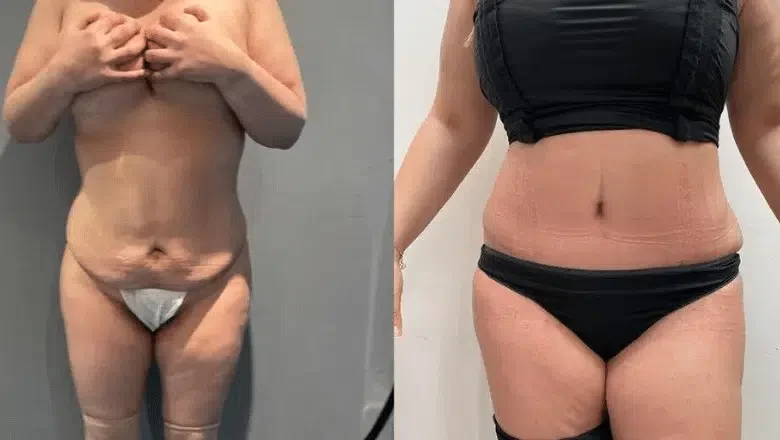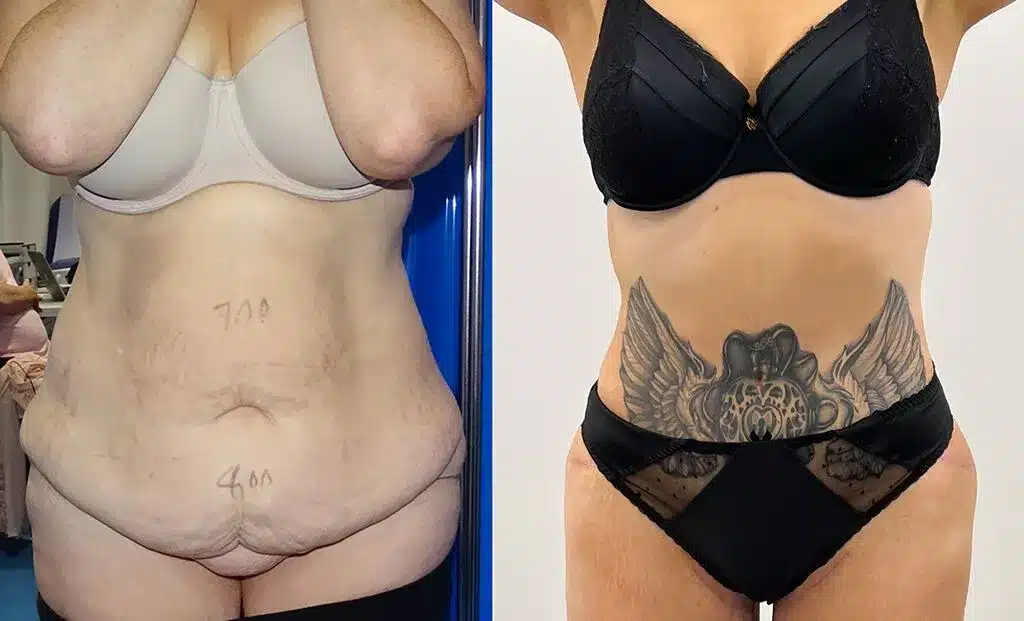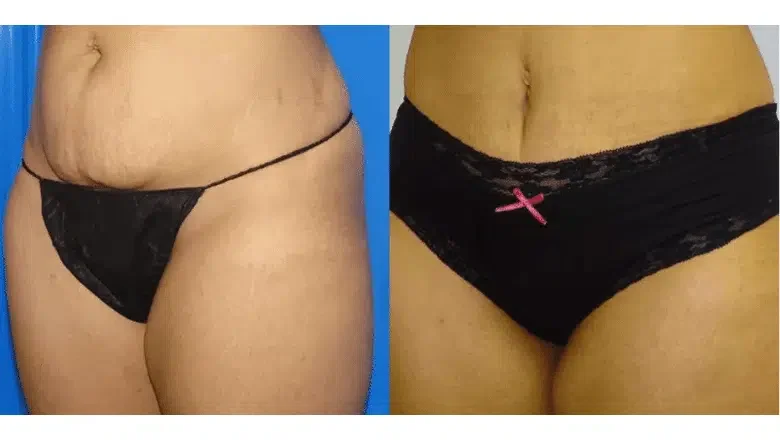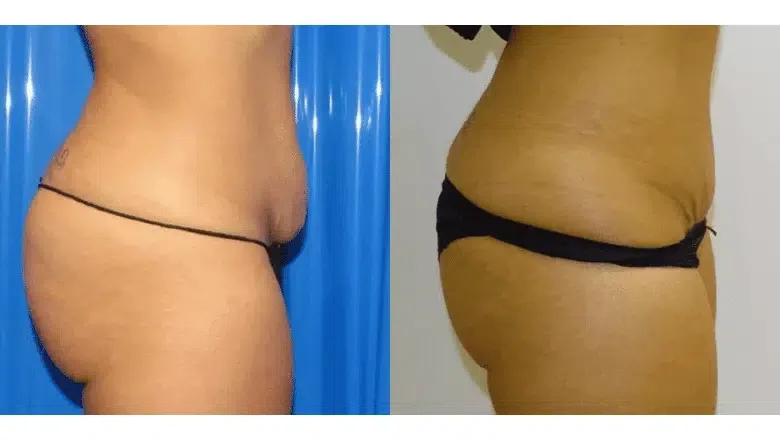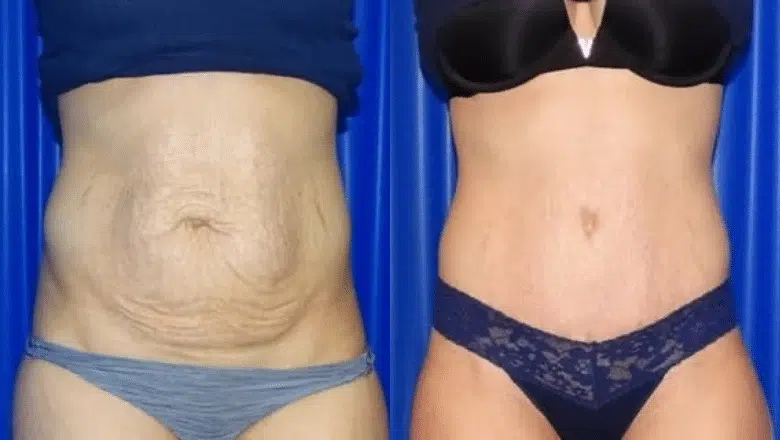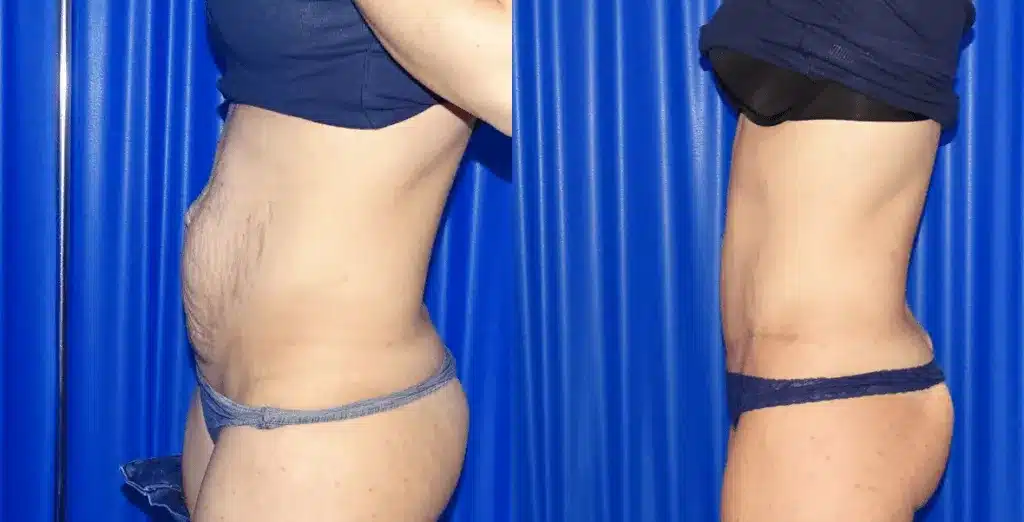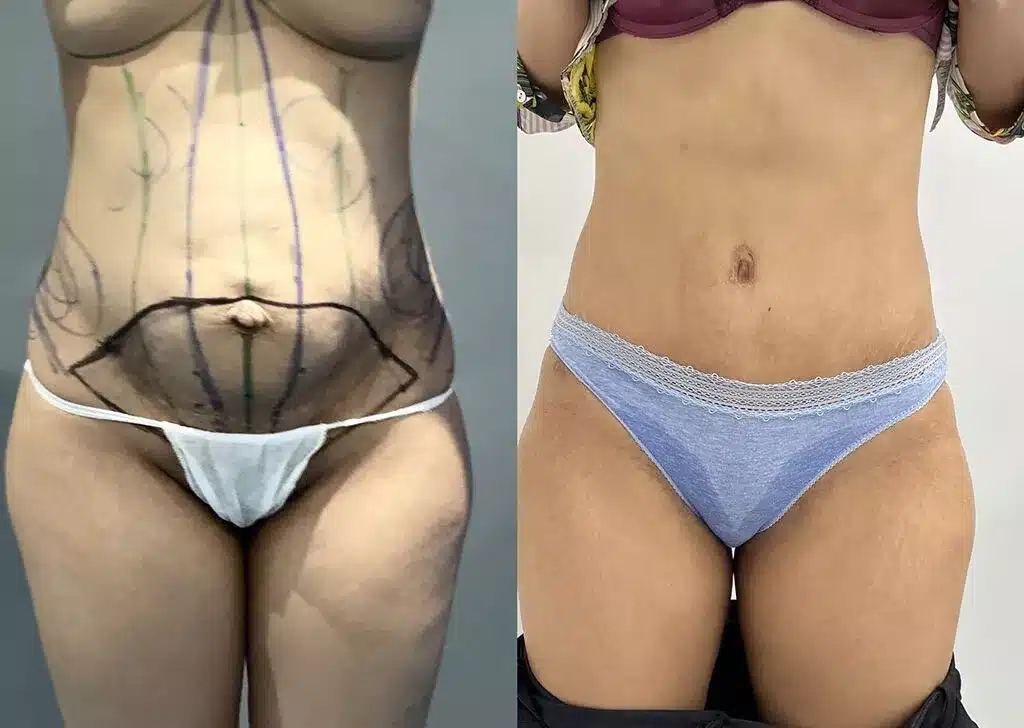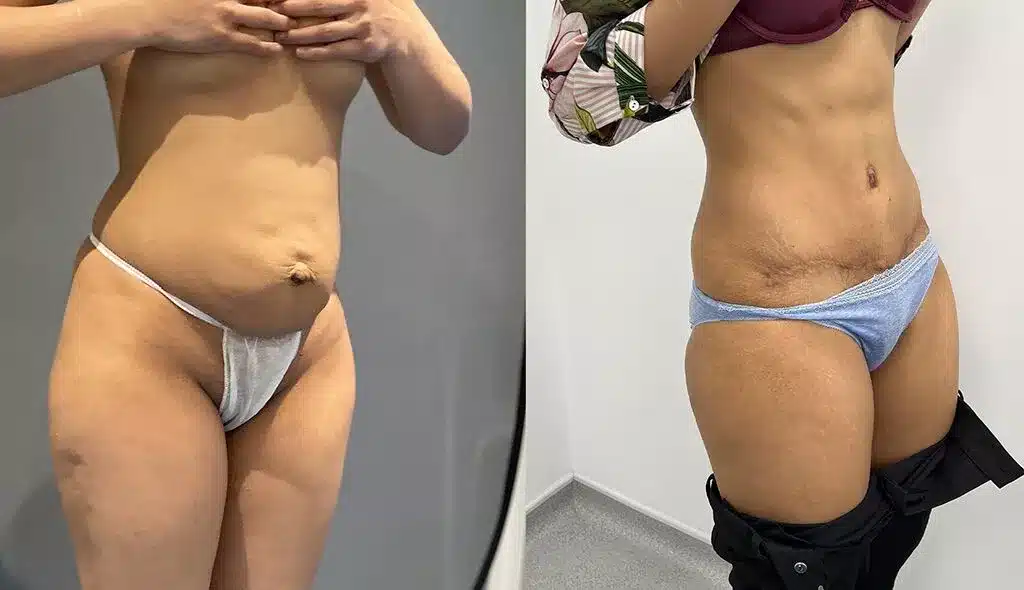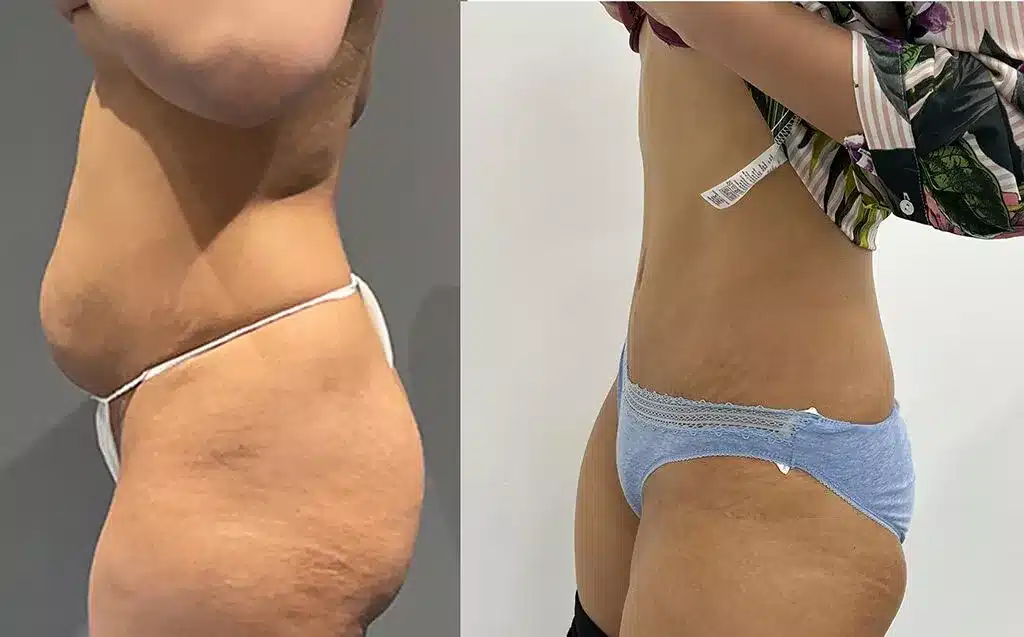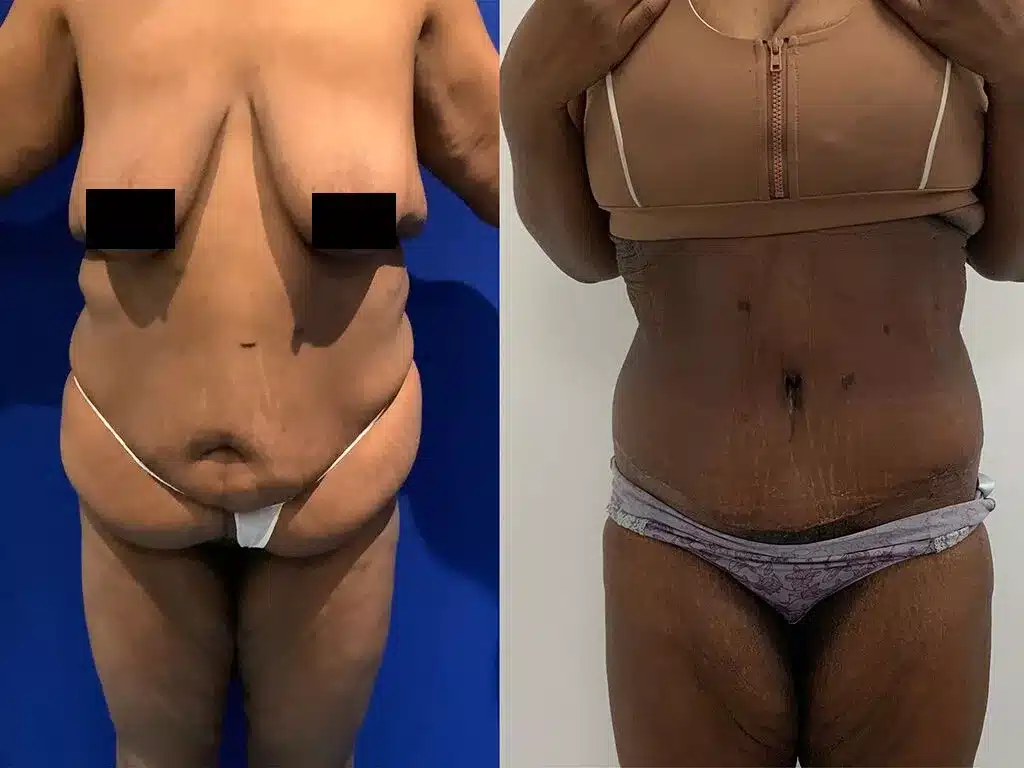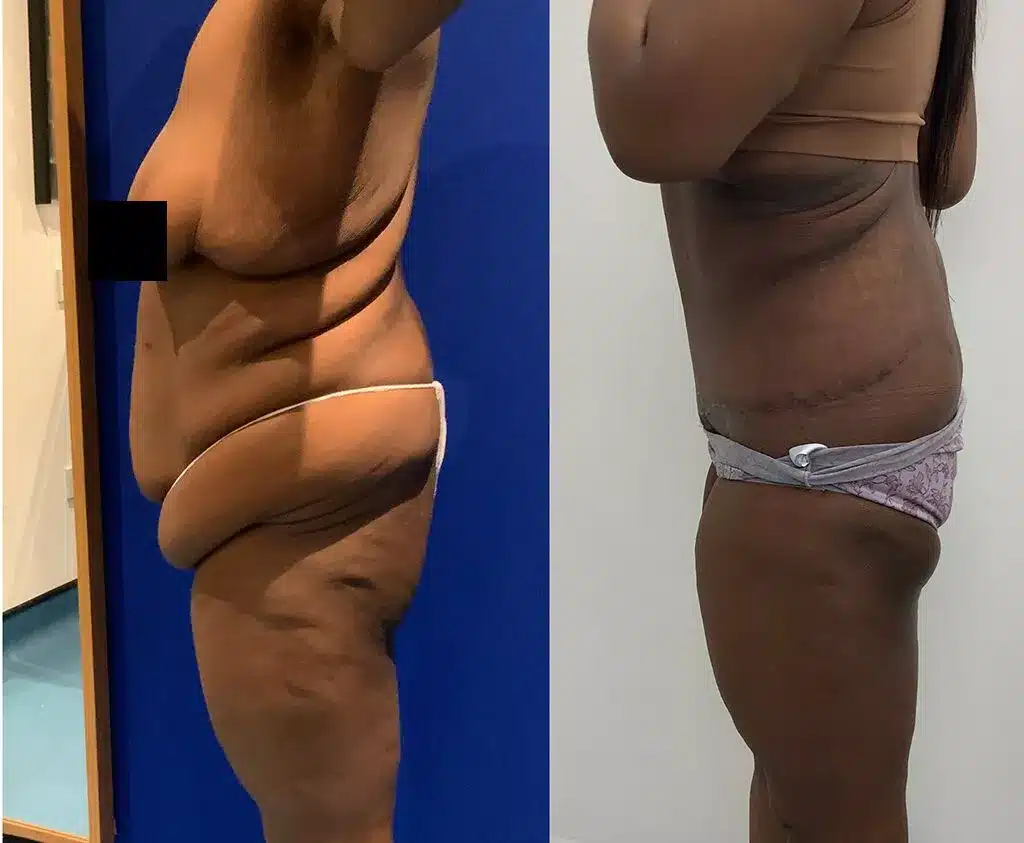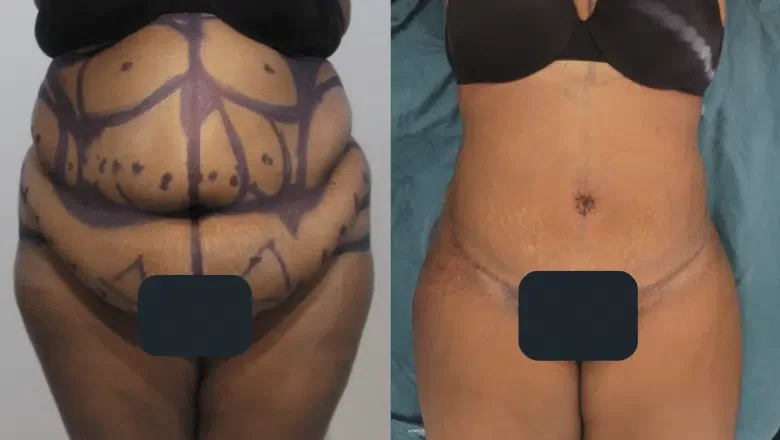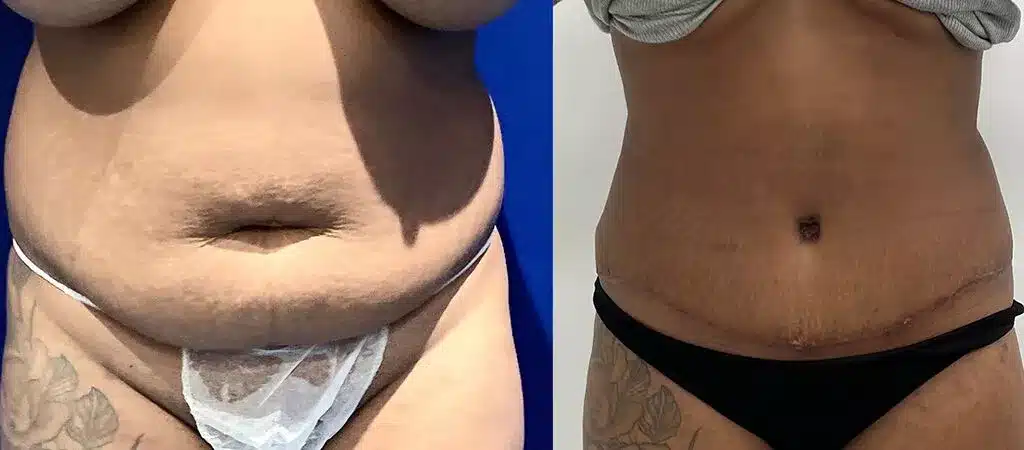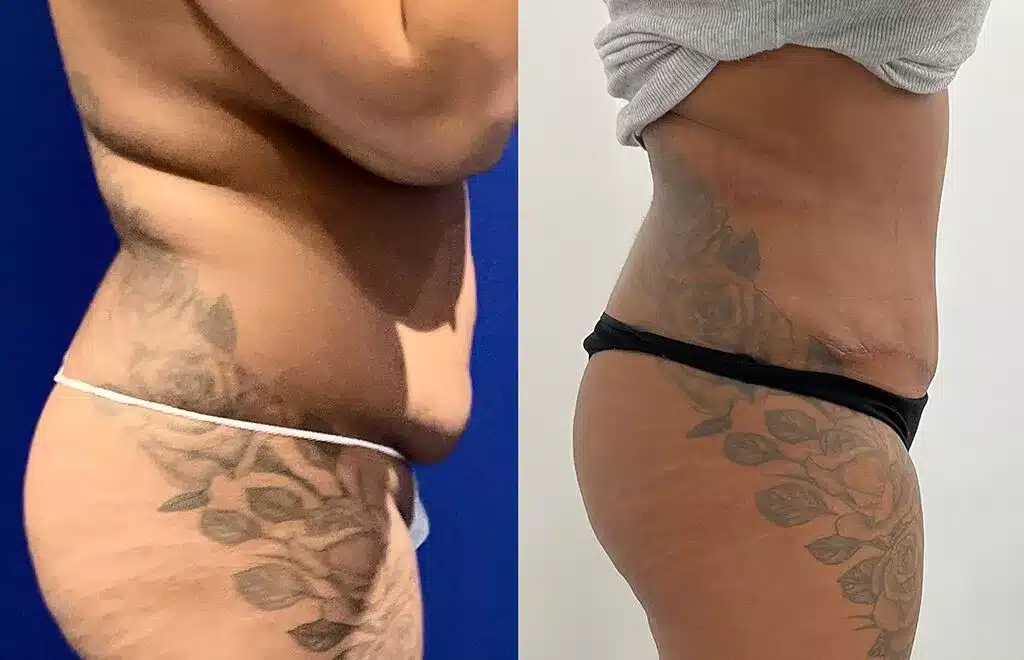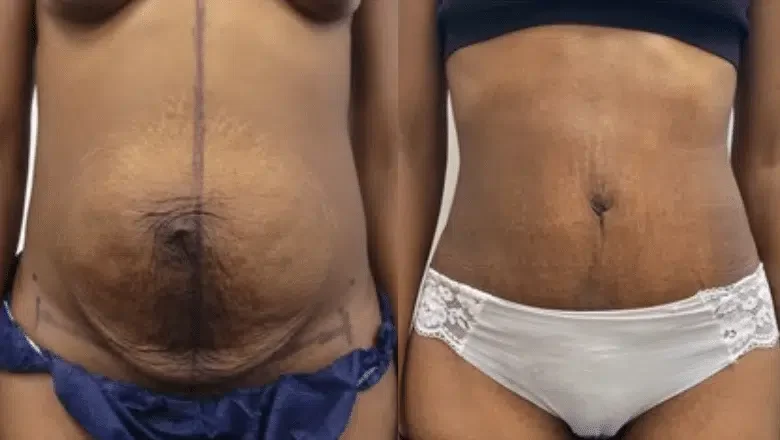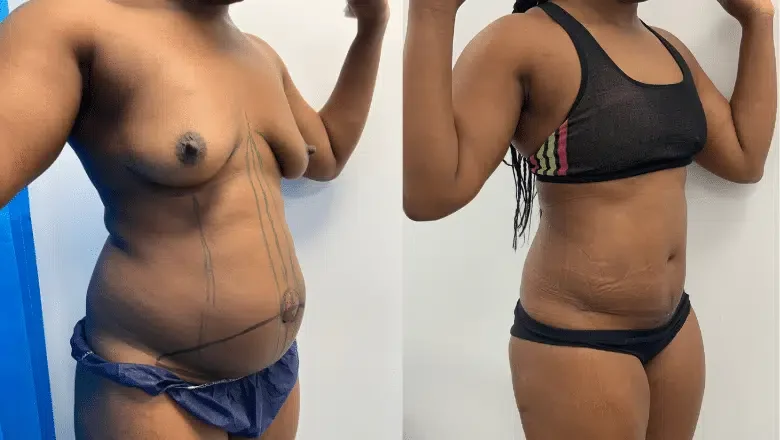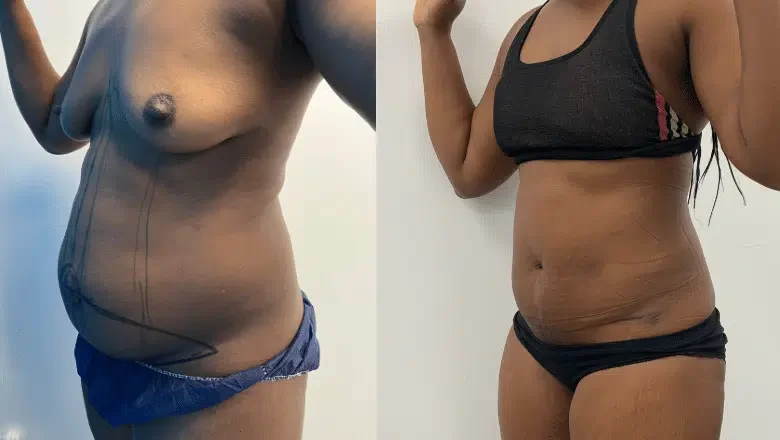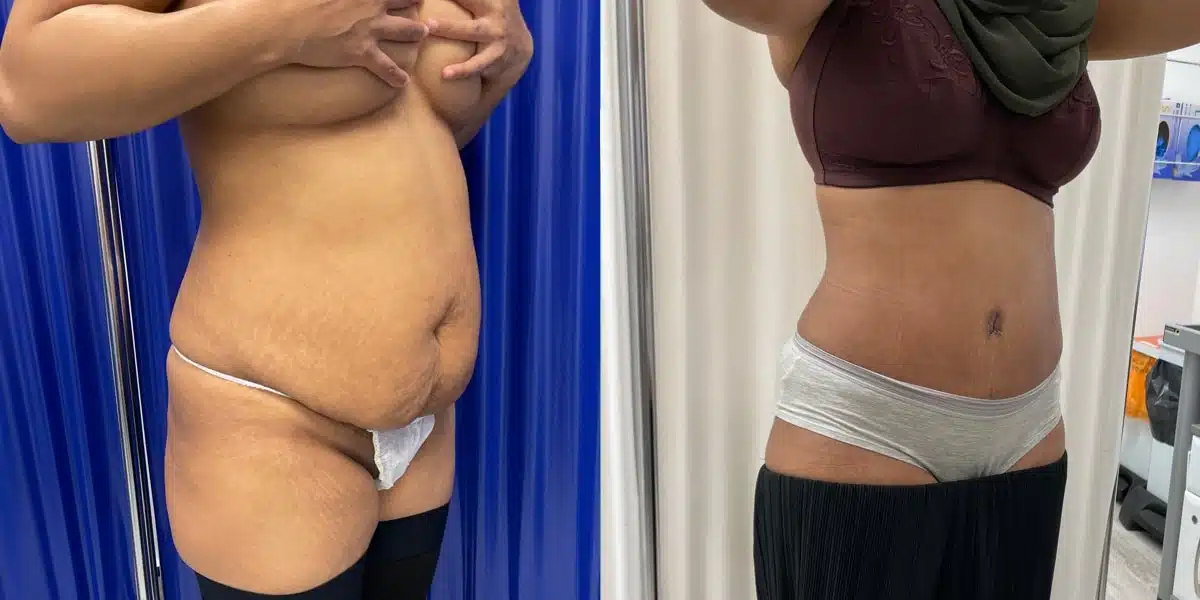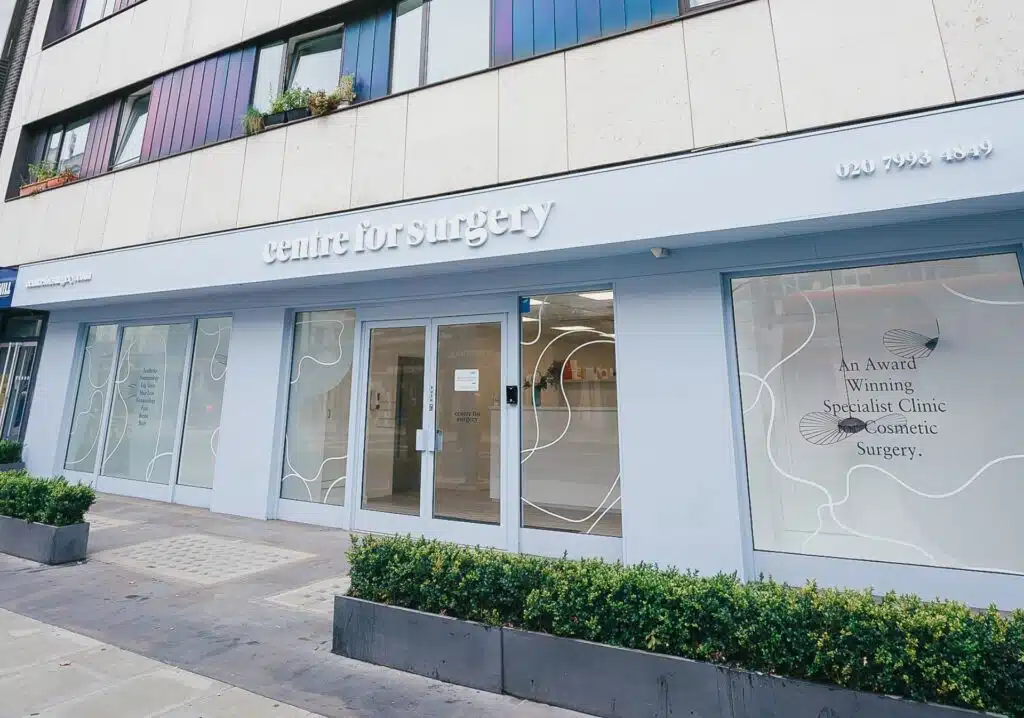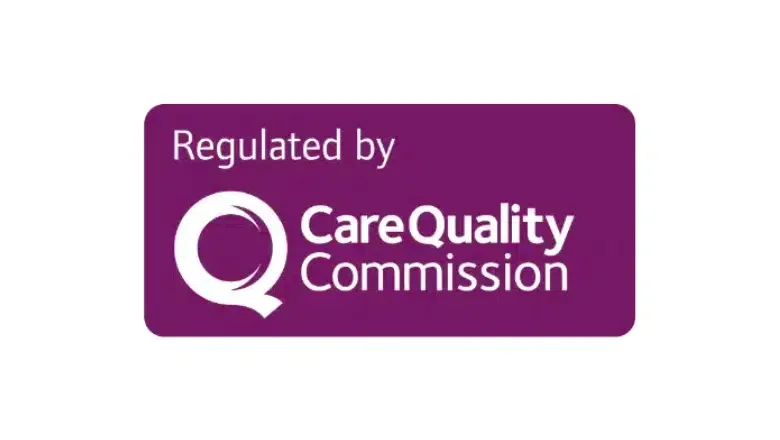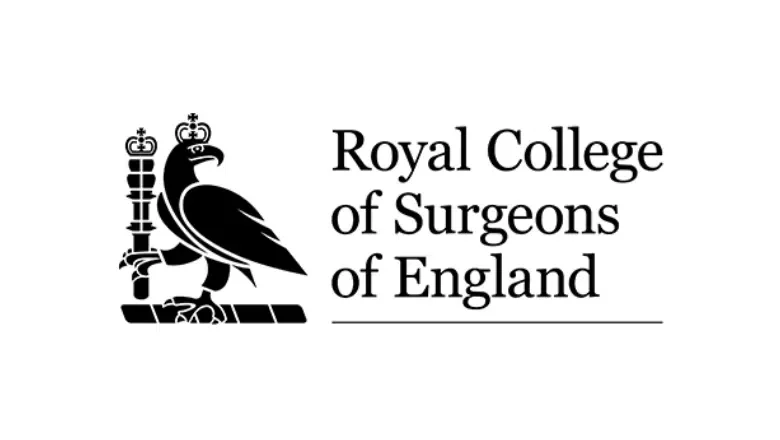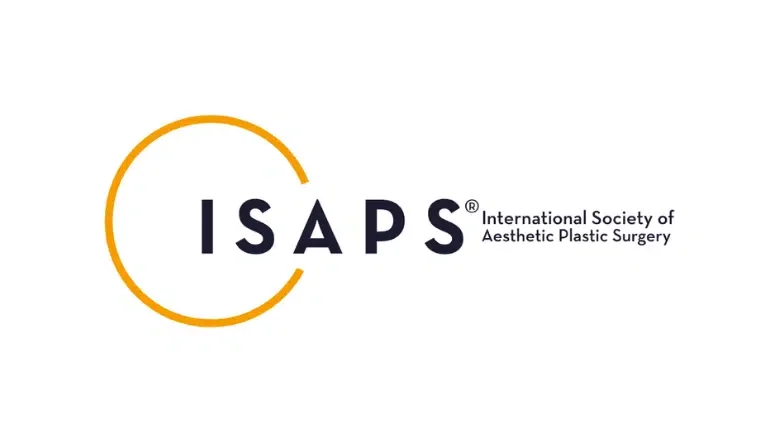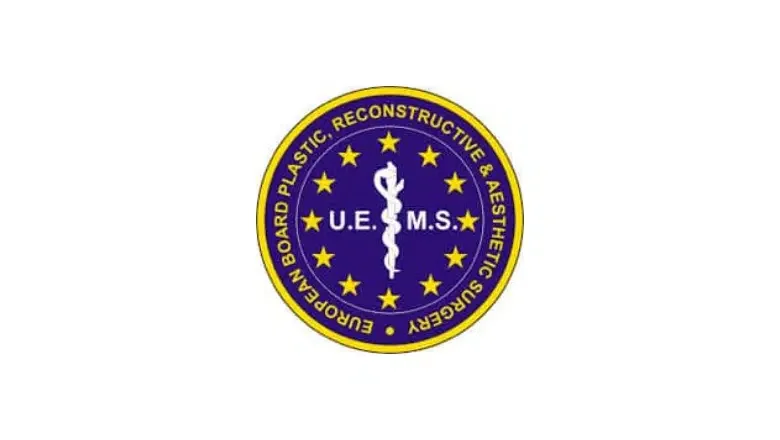Tummy Tuck in London
Abdominoplasty, more commonly known as a tummy tuck, is a transformative cosmetic surgery that aims to sculpt the abdomen into a more toned and aesthetically pleasing shape. This procedure meticulously removes any excess, sagging skin and tightens the muscles within the abdominal wall. The result is not only a flatter, more refined stomach appearance but also the resolution of certain medical issues, notably diastasis recti—the separation of the abdominal muscles. Given its impressive outcomes, it’s hardly surprising that abdominoplasty ranks among the most sought-after cosmetic surgeries in the UK.
A tummy tuck is particularly beneficial for individuals who have experienced significant weight loss, leading to loose and hanging skin that no longer responds to diet and exercise. It is also advantageous for older individuals who naturally produce less collagen, making their skin prone to sagging, even with minor weight changes.
Following pregnancy and childbirth, many women find themselves struggling with an excess of abdominal skin and weakened muscles, contributing to a variety of health concerns such as lower back pain and poor posture. In these instances, a tummy tuck that includes muscle repair can offer relief by addressing the muscle separation and removing the excess skin, thereby sculpting a more contoured and visually appealing midsection. Furthermore, women who have gone through menopause and are not planning any more pregnancies might consider a tummy tuck to reclaim the firmness and shape of their abdomen.
RELATED: Tummy Tuck FAQs – Q&As about Abdominoplasty Surgery
Our team of surgeons is renowned for expertise in body contouring, bringing a wealth of experience to every abdominoplasty procedure they perform. Tailoring each treatment plan to the individual, our specialists ensure that every patient receives a personalised journey towards enhancing their abdominal aesthetics.
| Tummy tuck | Fast facts |
|---|---|
| Procedure time ⏳ | 2-4 hours |
| Anaesthetic type 💉 | General anaesthetic |
| Length of stay 🛏 | Day case |
| Up and mobile 🚶🏻♂️ | 1 day |
| Washing 🛁 | 1 week |
| Travel ✈️ | 4 weeks |
| Sexual activity ❤️ | 6 weeks |
| Driving 🚗 | 4 weeks |
| Postoperative garment 👕 | 6 weeks |
| Sleeping 😴 | On back for 4 weeks |
| Exercise 🏃🏽♀️ | 6 weeks |
| Full recovery 🕺🏻 | 6 weeks |
| Final results 😃 | 6 months |
Tummy Tuck Before & After Photos - Real Patient Results
Browse our tummy tuck photo gallery to see the results achieved by our surgeons at Centre for Surgery. The before-and-afters below offer a sampling of the patient photos we have on file. When you come to see us for a consultation, a wide variety will be available.
Gallery 1:
Gallery 2
African-Caribbean Tummy Tuck
If you are considering an abdominoplasty or tummy tuck and would like to see the quality of results our surgeons have achieved, we invite you to explore our tummy tuck photo gallery. This gallery features a curated selection of photographs showcasing the outcomes of actual patients who have undergone this transformative procedure at our clinic.
RELATED: Tummy Tuck (Abdominoplasty) Before And After Photos
What is a Tummy Tuck?
A tummy tuck is a surgical procedure designed to remove excess skin and fat from the middle and lower abdomen. It also tightens the muscles of the abdominal wall to achieve a flatter and more toned stomach. While highly effective, it’s important to note that the procedure can leave a significant scar, typically extending from hip to hip, depending on the extent of the surgery required.
The duration of a full tummy tuck can range from two to three hours. This variation depends on the patient’s specific needs and goals. For those requiring less extensive modifications, a mini-tummy tuck might be more suitable, typically lasting between one and two hours. This option involves a shorter incision and does not usually require repositioning of the navel.
The surgical process for a full tummy tuck involves making a long incision from one hipbone to the other, positioned just above the pubic area. A second incision around the navel frees it from surrounding tissues. The surgeon then lifts the skin to the ribs, exposing the vertical abdominal muscles. These muscles are then tightened and sutured to refine the abdominal contour and narrow the waistline.
In contrast, the mini-tummy tuck focuses on the area below the navel. Only the skin between the incision line and the navel is lifted. This smaller skin flap is then stretched downward, excess skin is removed, and the remaining skin is reattached, resulting in less dramatic but still noticeable improvements.
Both types of tummy tuck surgery aim to provide patients with a smoother, firmer abdominal profile, addressing issues that cannot be corrected through exercise and diet alone. Whether a full or mini-tummy tuck is more appropriate will depend on the individual’s condition and aesthetic goals, which can be thoroughly discussed during a consultation with a skilled plastic surgeon.
Benefits of a Tummy Tuck (Abdominoplasty)
A tummy tuck is optimal for both women and men who are in good health, physically fit, and either close to their ideal body weight or have achieved a stable weight following significant weight loss. For individuals who have devoted considerable time and effort to rigorous dieting and exercise but are still struggling to achieve a flat, toned stomach or firm up loose skin marred by stretch marks, undergoing surgery may enhance their overall appearance. As a result, they can regain self-assurance when wearing form-fitting clothing and no longer feel the need to conceal their figure in baggy garments.
There are numerous advantages associated with abdominoplasty surgery, such as:
Elimination of surplus skin and fat in the abdominal region
The procedure effectively removes excess skin and fat, resulting in a smoother, more toned appearance.
Reinforcement of the underlying abdominal muscles
A tummy tuck not only addresses superficial issues but also strengthens the underlying abdominal muscles, providing added support to the spine and improving posture.
Enhancement of torso contours
By removing excess skin and fat and tightening the abdominal muscles, abdominoplasty surgery can help to create a more defined and aesthetically pleasing silhouette.
Restoration of a flat, smooth stomach
The surgery results in a smoother and flatter tummy, which can boost one’s confidence and comfort in various clothing styles.
Increased ease in fitting into regular clothes
With a flatter and firmer abdomen, patients often find that they can comfortably fit into a broader range of clothing, including form-fitting garments.
Reduction of irritation, chafing, and infections in the lower abdominal fold
Excess skin and fat in the lower abdomen can cause discomfort and irritation due to friction and chafing. By eliminating this excess tissue, abdominoplasty surgery can alleviate these issues and reduce the risk of infections.
Enhanced exercise tolerance and support for weight loss activities
After undergoing abdominoplasty surgery, patients often experience improved exercise tolerance and find it easier to engage in physical activities that can further aid in their weight loss journey. This can contribute to an overall healthier lifestyle and promote long-term weight maintenance.
Who is a Good Candidate for a Tummy Tuck?
Determining your suitability for abdominoplasty, or a tummy tuck, depends on several factors. While only a consultation with a qualified plastic surgeon can give you an accurate assessment, the following criteria can help you evaluate whether you might be a suitable candidate:
Physical health
Ideal candidates for abdominoplasty are in good overall health and do not have any medical conditions that could impair the healing process or increase the risk of complications during surgery.
Stable weight
It is recommended that you are close to your ideal body weight or have maintained a stable weight after significant weight loss. Abdominoplasty is not a weight loss solution; rather, it is a body contouring procedure to address excess skin and fat and tighten abdominal muscles.
Realistic expectations
It is essential to have a clear understanding of what the surgery can achieve and to maintain realistic expectations regarding the results. While abdominoplasty can significantly improve your appearance, it is not a guarantee of perfection.
Non-smokers
Smoking can increase the risk of complications and negatively impact the healing process. If you are a smoker, you will be advised to quit smoking well before the surgery and during the recovery period.
Completed pregnancies
If you are a woman considering future pregnancies, it is advisable to postpone abdominoplasty until after you have completed your family. Pregnancy can stretch the abdominal muscles and skin, potentially reversing the results of the surgery.
Commitment to a healthy lifestyle
Candidates should be committed to maintaining a healthy lifestyle, including a balanced diet and regular exercise, to preserve the long-term results of the surgery.
Types of Tummy Tuck
Full Abdominoplasty or Full Tummy Tuck – including muscle repair
A full abdominoplasty involves the removal of redundant, extra tissue, including skin and fat. The muscle layer is also reconstructed, which helps to create a narrower torso. Repairing the muscle layer is also referred to as rectus diastasis repair. A full abdominoplasty is ideal for patients after pregnancy or who have undergone weight loss. Traditional abdominoplasty does not involve liposuction and has become somewhat of an obsolete technique in recent years.
Mini Tummy Tuck or Mini Abdominoplasty – usually not including tummy muscle repair
A mini-abdominoplasty is a smaller procedure than a full abdominoplasty. The procedure involves removing the loose skin from below the umbilicus. The procedure also involves the surgical tightening of the lower abdominal muscles. A mini-abdominoplasty is ideally suited for patients on the lower end of BMI (BMI<23) who have skin laxity below the umbilicus only and not above the umbilicus. The scar from a mini tummy tuck is shorter, with a shorter recovery and downtime. A full abdominoplasty may be more suitable with skin laxity above the umbilicus. As with a Brazilian abdominoplasty, liposuction is used to contour the waist and is performed as a day case without any requirement for the insertion of drains.
One of the main advantages of a mini tummy tuck is that it can address smaller, more localised areas of the abdomen in those who otherwise have good skin elasticity. Like a full tummy tuck, a mini tummy tuck is a highly effective surgical technique that tightens and contours the lower abdomen, yielding long-term results, provided that patients maintain a healthy diet and a stable weight.
Brazilian abdominoplasty – Combining Liposuction & Tummy Tuck
A full abdominoplasty has generally been a major surgical procedure with recognised complications, including postoperative bleeding, seroma formation, delayed wound healing and abnormal scarring. Complications often require many post-op doctor appointments, leading to an unsatisfactory outcome. Surgeons at Centre for Surgery specialise in the Brazilian tummy tuck or Brazilian abdominoplasty, similar to a full abdominoplasty. It involves removing excess skin, repairing the rectus muscle, and creating a new position for the belly button. The key difference is the addition of liposuction to the above, which facilitates a gentler method of mobilising the excess skin without excessive dissection and compromise of the blood supply to the skin flap. This leads to improved healing and a reduced risk of postoperative wound complications.
A Brazilian tummy tuck should not be seen as a lesser version of a full tummy tuck. It does not involve additional steps and is a more effective body contouring procedure than the traditional ‘cut and shut’ abdominoplasty, which is still the most commonly performed procedure in the UK. A Brazilian tummy tuck takes longer to perform than a full tummy tuck due to the extra liposuction required, but the dramatic results achieved are well worth the extra time needed. In keeping with all the other types of tummy tucks performed at Centre for Surgery, a Brazilian tuck is performed as a day-case procedure and has a more favourable side-effect risk profile than a full abdominoplasty.
Benefits of Brazilian Abdominoplasty:
- Significantly less postoperative pain and discomfort
- A shorter period of downtime
- Lower risk of localised seroma or haematoma formation
- A day case procedure, which means you can go home and recover, leading to better healing.
- A more defined and smaller waist as a result of liposuction, combined with the tummy tuck
Downsides of a traditional tummy tuck:
- An inpatient stay of 2-3 nights is required with the risk of acquiring nasty hospital superbugs
- Increased period of recovery required
- Higher risk of haematoma formation
- More pain, and with a regular requirement for postoperative opioid medicines given IV
Extended Abdominoplasty
Extended abdominoplasty involves the removal of extra skin and tissue from the flanks in addition to the abdomen. This often requires liposuction in addition to skin excision. The incision is longer than that of a full abdominoplasty to ensure complete side correction. If you have extra muscle looseness in the hips and flank area in addition to abdominal laxity, an extended abdominoplasty may be an appropriate option. Liposuction is always a key component of an extended abdominoplasty.
Fleur-De-Lis abdominoplasty
A subset of patients who present for abdominoplasty surgery will have extra redundant skin both vertically and laterally. A standard abdominoplasty may not adequately address the loose skin located centrally. The Fleur-De-Lis technique of tummy tuck involves both the standard low horizontal incision and a vertical incision. The resulting incision resembles an inverted T shape with a small midline vertical aspect extending from the midline of the horizontal scar upwards towards the belly button.
Circumferential abdominoplasty or Body Lift
A circumferential abdominoplasty, or 360 tummy tuck or body lift, is a major procedure compared with a standard full abdominoplasty. It is an ideal procedure for massive weight loss patients who often have extensive hanging skin around their torso. The incision encircles the torso and is performed in two stages: first, the front is addressed, followed by the back and sides. Circumferential abdominoplasty is often combined with a thigh and buttock lift. This is known as a lower body lift or belt lipectomy – A major body contouring procedure. At Centre for Surgery, body lift surgery is always carried out in a two-stage procedure to ensure proper healing.
Caesarean section scar revision
After a Caesarean section, it is not uncommon to develop a prominent fold of skin that sits above the C-section scar. The prominence of the scar is due to the attachment of the scar to deeper structures, and therefore, any fat or lax skin above looks much more apparent. Many women notice that the bulge protrudes through tight-fitting clothing. The extra skin and fat can be surgically removed, and this can be combined with liposuction if appropriate. The Caesarean scar revision procedure is often performed under local anaesthetic and is a day-case procedure.
Revision abdominoplasty
Our surgeons are seeing a growing number of patients who have undergone tummy tuck surgery with another surgeon elsewhere and are dissatisfied with their results. Our surgeons have sub-specialist expertise in abdominal wall reconstruction within the NHS and have years of experience performing revision tummy tuck surgery for patients who underwent their initial procedure elsewhere, often overseas in countries like Turkey.
Reasons to seek a revision tummy tuck:
- Excess fat was not removed at the original procedure
- A poorly shaped umbilicus
- Insufficient muscle repair
- An unsightly scar
- A poorly placed scar (often too high)
RELATED: Can I Get A Second Tummy Tuck?
Preparing for Your Tummy Tuck
We take pride in assisting hundreds of patients in achieving their desired abdominal aesthetics through tummy tuck surgery. Understanding that the prospect of abdominoplasty can be daunting, our surgeons offer personalised consultations to alleviate concerns and ensure clear communication about the procedure and expected outcomes.
Consultation and Personalised Planning
During your consultation, our surgeons will conduct a thorough physical examination and review your medical history. This is an opportunity to discuss your aesthetic goals in depth. Our surgeons dedicate ample time to each consultation, ensuring that you fully understand the realistic outcomes of the surgery.
Determining the Appropriate Procedure
Your surgeon will evaluate your specific needs to determine the most suitable type of tummy tuck. For instance, if excess fat is localised below the navel, a mini-tummy tuck might be recommended. This less invasive option can often be performed on an outpatient basis, offering quicker recovery times. In cases where fat deposits extend beyond the abdominal area, combining a tummy tuck with liposuction might be advised to achieve optimal body contouring, particularly around the hips. In certain scenarios, liposuction alone may be sufficient to achieve your goals.
Preoperative Instructions
To ensure the best possible results and a smooth recovery, your surgeon will provide detailed instructions on how to prepare for the surgery. This includes advice on nutritional supplements and medications. Smokers will be advised to quit smoking at least four weeks before the surgery and throughout the recovery period, as smoking can impede circulation and hinder healing.
Tummy Tuck Procedure
Tummy tuck surgery is performed at Baker Street Clinic using TIVA general anaesthesia. All our tummy tucks are outpatient procedures, meaning you will be admitted and discharged on the same day. Centre for Surgery is one of only a handful of providers in the UK that specialise in day-case abdominoplasties.
On average, a full abdominoplasty takes 3-4 hours to perform. For combined procedures such as breast augmentation or breast lift, the procedure duration could be 5-6 hours.
Step-by-step tummy tuck
- STEP 1: You will be placed under general anaesthesia
- STEP 2: If required, the surgeon will perform liposuction to the flanks – you will lie on your front for this step
- STEP 3: Liposuction using the SAFElipo technique is performed on the abdomen
- STEP 4: The belly button is freed from the surrounding skin with a circular incision
- STEP 5: An incision is made along the lower abdomen just above the pubic hairline – the length will vary depending on the amount of skin to be removed
- STEP 6: The abdominal skin flap is created to the lower part of the sternum, and the redundant skin is then removed
- STEP 7: The abdominal muscles are repaired
- STEP 8: The belly button is brought out to a suitable position and sutured in position
- STEP 9: The abdominal incisions are closed
- STEP 10: Two drains are inserted, dressings are applied, and a postoperative compression garment is applied
An abdominoplasty is performed as an outpatient surgery. This means you will be able to return home the same day as your tummy tuck and recover in the comfort of your own home. You will need someone to drive you home, and you may wish to have someone stay with you for the first few days following the procedure.
Tummy Tuck (Abdominoplasty) Recovery
After the abdominoplasty procedure, your surgeon will insert drains beneath the abdominal skin, apply a specialised dressing to promote wound healing and fit you with a surgical compression garment. All abdominoplasty surgeries at the Centre for Surgery are performed as day cases, which means you will be able to go home later the same day. The drains may be removed before you are discharged from the clinic or during your first follow-up appointment on days 5-7.
RELATED: Recovery after Tummy Tuck – Top Tips after Abdominoplasty
During your recovery, your body will naturally remain slightly flexed at the waist and knees to increase comfort and alleviate tension on the incision site. The tight sensation in your abdomen may persist for several weeks post-surgery. You may also experience numbness around the incision area and the belly button, which could potentially be permanent. The surgical scar will gradually fade, starting around six months and taking up to two years to achieve its final appearance. Bruising and swelling may last for several months.
After discharge, you will receive pain management and antibiotic prescriptions. Ensure someone is available to fill your prescriptions, drive you home, and assist you during the initial days of your recovery. You may briefly remove the compression garment while at home and shower with the dressings in place.
Your return to regular activities should be gradual and paced according to your comfort level. Recovery times will differ between patients, but you should anticipate the following:
- Taking at least two weeks off work
- Refraining from driving for two weeks
- Avoiding moderate to high-intensity cardiovascular exercises for six weeks
- Waiting three months before resuming abdominal core exercises (such as sit-ups)
- Arranging for assistance with childcare for young children for at least the first three weeks post-operation
You will have a follow-up appointment with the nursing team within the first week after surgery to ensure your wounds are healing properly and to remove any necessary drains. Your surgeon will monitor your progress closely during the first year and guide scar management, wearing compression garments, and gradually resuming normal activities.
Adhering to all post-operative instructions provided by your surgeon is crucial for achieving the best possible outcome from your abdominoplasty surgery.
Tummy Tuck Results
Undergoing a tummy tuck, or abdominoplasty, marks the beginning of a journey towards achieving a more toned and streamlined abdomen. One of the most gratifying aspects of this procedure is the immediate visibility of results. From the moment you leave the operating room, the removal of excess skin will unveil a flatter and more defined stomach. However, the journey to witnessing the final outcome of a tummy tuck extends beyond this initial improvement.
The process of healing and the evolution of results follow a timeline that typically spans 6 to 12 months post-surgery. This period is crucial as it allows the body to recover fully and the residual swelling to subside completely. It’s essential to recognise that the pace at which these changes occur is influenced by the specific nature of the tummy tuck surgery being performed. Less invasive procedures often lead to a quicker resolution of swelling, thereby hastening the appearance of the final results.
The final outcome of a tummy tuck is a transformation that goes beyond the aesthetic. Patients can look forward to not only a flatter and more sculpted abdomen but also an enhanced sense of confidence and well-being. Removing unwanted skin and firming the abdominal area contribute to a more youthful and vigorous appearance.
Patients must also maintain realistic expectations regarding the healing process and diligently follow their surgeon’s post-operative care instructions. This includes embracing a healthy lifestyle and avoiding any activities that could jeopardise the results. With patience and proper care, the final results of a tummy tuck can offer lasting satisfaction, enabling individuals to enjoy a more contoured and aesthetically pleasing abdominal profile.
Tummy Tuck Risks & Complications
Every year, thousands of abdominoplasty, or tummy tuck, operations are successfully completed, providing many patients with positive outcomes. When carried out by an experienced and qualified surgeon, the likelihood of a successful procedure increases significantly. However, like all surgical interventions, abdominoplasty carries potential risks and specific complications inherent to the nature of the surgery.
Despite being uncommon, post-operative complications such as infections and blood clots can develop. Should an infection arise, it can typically be managed effectively with antibiotics and appropriate drainage methods. To reduce the incidence of blood clots, patients must begin mobilising as soon as it is safe after the operation. At our advanced plastic surgery clinic in London, we support our abdominoplasty patients by providing anti-embolic stockings, which are recommended for use for one week post-surgery. Additionally, we utilise a specialised compression pump during the procedure. This device gently massages the patient’s legs, working in conjunction with the stockings to significantly reduce the risk of blood clot formation in the legs.
Another potential issue following surgery is poor healing, which can lead to conspicuous scarring and might require a follow-up surgical intervention. We particularly advise smokers to quit, as smoking not only heightens the risk of experiencing complications but also impedes the healing process.
Patients can further reduce their risk of complications by diligently following their surgeon’s pre- and post-operative instructions. This includes guidance on the timing and manner of resuming physical activities, which plays a critical role in a smooth recovery and the overall success of the surgery. By following these guidelines, patients can enhance their recovery process and mitigate the risks associated with abdominoplasty.
How to look after tummy tuck scars
Our surgeons are trained to create low transverse incisions which sit directly above the pubic area. The length of the tummy tuck scar will depend on the type of tummy tuck that is chosen. The appearance of the tummy tuck scars will be influenced by proper care of the area and following the post-procedure instructions to optimise its appearance.
Top Tips to Help with Tummy Tuck Scar Healing
- It is important to keep the postoperative dressings for the recommended duration.
- Avoid stretching the area too much. An example would be bending backwards, which may stretch the scar.
- Avoid sun exposure. Sun exposure leads to excess scarring, and delays wound healing.
- Use recommended silicone scar gels and medical-grade brown tape.
- Have patience. Any scar takes time to mature and fade. Scars that are still overly prominent can be treated with several modalities, including laser or Morpheus8.
Tummy Tuck Cost London - How much does a tummy tuck cost London UK? Prices & Fees
There are a number of factors that will determine the overall cost of your tummy tuck procedure, and the final quotation will be given after a face-to-face consultation with your specialist plastic surgeon.
- Type of tummy tuck – full, mini, extended or revision
- Tummy tuck combined with another procedure such as breast surgery
- Number of areas of liposuction in combination with a tummy tuck
- Primary or revision tummy tuck
Why not call 0207 993 4849 and speak to one of our expert patient coordinators who may be able to give you a rough costing prior to a consultation for a tummy tuck.
Always remember that price should never be the determining factor when it comes to choosing a plastic surgeon for your tummy tuck procedure. We feel that safety and quality of service should be your number one priority and instil in you the confidence that our team will look after you before, during and after your procedure to the best of their ability.
What is included in my treatment package?
- As many preoperative consultations with your surgeon as you like to make sure the tummy tuck procedure is right for you
- Treatment at a specialist day surgery facility recently rated ‘Good’ by the CQC
- Enhanced same-day discharge with the added benefits of recovering in your own home
- 24/7 clinical support from your surgeon for the first 48 hours and our expert postoperative support team
- Your very own dedicated patient coordinator available to answer all your questions
- In-depth preoperative medical assessment to make sure you are fully fit for your tummy tuck procedure
- Exceptionally high standards of postoperative care are described as ‘outstanding’ by the CQC with regular telephone and face-to-face checks to ensure you are healing well.
Spread the cost of your tummy tuck procedure – from as little as £120 per month.
Centre for Surgery is fully approved to offer finance via our specialist finance partner, Chrysalis Finance. no longer need to use your savings to pay for your treatment – you can apply to spread the cost of your procedure with Chrysalis Finance using their simple 1,2,3 application to pay for your procedure. Don’t wait until you have enough money for your treatment. Apply today and (subject to status) pay for your procedure easily in monthly instalments using one of their payment options. Chrysalis Finance is the only ethical provider that focuses solely on the provision of specialist financing for medical procedures.
Complementary Procedures
At Centre for Surgery in London, we understand that achieving your ideal body shape is often a journey that involves more than a single procedure. That’s why we offer a suite of complementary surgeries that can be paired with a tummy tuck (abdominoplasty) for a holistic body transformation. Each of these additional procedures is designed to address specific concerns, allowing for a tailored approach to cosmetic enhancement.
RELATED: Combining Cosmetic Surgery Procedures
Tummy Tuck and Liposuction
Abdominoplasty is a transformative procedure focused on removing loose, excess skin and tightening the abdominal muscles. However, for patients looking to eliminate stubborn fat deposits that are resistant to diet and exercise, combining a tummy tuck with liposuction offers a comprehensive solution. Liposuction, or suction-assisted lipectomy, precisely targets and removes significant amounts of excess fat through a minimally invasive technique. A surgeon performs this by creating a small incision, inserting a suction tube into the treated area, and meticulously sculpting the body’s contours. This combination not only flattens the abdomen but also refines and enhances the overall silhouette, offering a more pronounced and aesthetically pleasing body shape.
Mummy Makeover
For many women, the physical changes brought about by pregnancy and breastfeeding can be challenging to reverse through exercise and diet alone. The mummy makeover is a bespoke package designed to address these specific changes, combining a tummy tuck, liposuction, and breast surgery into a comprehensive treatment plan. Depending on individual goals and needs, breast augmentation can be achieved through fat transfer or implants, while a breast lift or breast reduction may be recommended to achieve the desired contour and lift. This tailored series of procedures aims to restore the body to its pre-pregnancy appearance, focusing on enhancing the upper body’s shape and tone for a balanced and rejuvenated silhouette.
Tummy Tuck in London: Discover Excellence at Centre for Surgery
Choosing the right clinic for your tummy tuck procedure is a decision that sets the tone for your entire cosmetic surgery journey. We are dedicated to providing our patients with unparalleled care, expertise, and results that speak for themselves. Our state-of-the-art facilities, combined with our team of highly skilled surgeons, ensure that every patient receives a bespoke treatment plan tailored to their unique needs and goals.
Unmatched Expertise and Patient-Centred Care
Our surgeons are renowned for their expertise in abdominoplasty, offering a range of techniques to meet the diverse needs of our patients. From the initial consultation to post-operative care, our team is committed to ensuring your comfort, safety, and satisfaction throughout the entire process.
Patient Testimonials
“After years of feeling self-conscious about my post-pregnancy body, I finally decided to undergo a tummy tuck at Centre for Surgery. The results have been life-changing. Not only do I look better, but I also feel more confident in my own skin. The staff were incredibly supportive, and my surgeon was thorough in explaining the procedure and answering all my questions.” – Emma, 38
“Choosing Centre for Surgery for my tummy tuck was the best decision I could have made. The care I received was exceptional from start to finish. The results exceeded my expectations, and the recovery was smoother than I anticipated, thanks to the detailed aftercare instructions provided by my surgeon.” – Michael, 45
“The professionalism and kindness shown by everyone at Centre for Surgery were outstanding. My tummy tuck has not only improved my appearance but also my overall well-being. I am so grateful to my surgeon and the entire team for their dedication and expertise.” – Sarah, 51
Book Your Consultation Today
Embarking on your transformation journey begins with a consultation at our clinic. To book your appointment and discuss your tummy tuck options with one of our expert surgeons, please contact us at:
- Phone: 0207 993 4849
- Email: contact@centreforsurgery.com
- Address: 95-97 Baker Street, London W1U 6RN
For more information about our clinic and the exceptional level of care we provide, please visit our About Us page.
Explore Our Comprehensive Resources
To assist you in making an informed decision about your tummy tuck procedure, we offer a wealth of resources:
- Finance Options: Learn about our flexible finance options, including 0% APR with Chrysalis Finance, by visiting our finance options page.
- Plastic Surgery Blog: For insights, tips, and more information on tummy tucks and other procedures, explore our plastic surgery blog.
- Clinic FAQs: Have questions? Find answers to frequently asked questions about cosmetic surgery at our Clinic FAQs page.
- Baker Street Clinic: Discover our flagship location and the heart of our operations by visiting the Baker Street clinic page.
FAQs
-
What does the perfect looking abdomen look like?Achieving a great tummy tuck result requires the surgeon to consider the position of the transverse lower scar, the position and shape of the umbilicus, the waist-to-hip (WHR) ratio, and the definition of the underlying abdominal wall musculature. These considerations differ in female and male patients and must be taken into account because an ever-increasing range of patients seeks abdominal contouring procedures.
The transverse tummy tuck scar should be well hidden by undergarments and swimwear. The popularity of swimwear and clothing that sits lower on the hips and abdomen dictates placing this incision approximately 5–9 cm above the vaginal opening in women and below prior scars such as for c-sections.
Contour abnormalities of the abdomen can be classified based on skin laxity, amount of underlying fat, and muscle wall weakness with bulging and laxity to create a treatment algorithm using these techniques.
Type 1: minimal skin laxity and minimal muscle laxity treated with liposuction alone;
Type 2: mild skin laxity and muscle laxity confined to below the belly button treated with skin excision and muscle repair of the lower abdominal wall (mini-abdominoplasty);
Type 3: moderate skin laxity and muscle laxity above the belly button treated with abdominoplasty with or without creating a new belly button (modified abdominoplasty);
Type 4: significant skin laxity and muscle laxity treated with full abdominoplasty with or without liposuction. -
What is a tummy tuck?Tummy tuck surgery is designed to tighten the skin of the abdomen through the removal of excess skin, remove stretch marks, removal of fat with liposuction and tightening of the abdominal muscles weakened by pregnancy or weight gain. Abdominoplasty surgery achieves more than what a good diet and exercise can achieve. Even heavy exercise will not be able to reverse muscle bulging caused by pregnancy. Liposuction is an integral part of a modern tummy tuck procedure to contour the waist.
-
What is an abdominoplasty?An abdominoplasty is also known as a tummy tuck or abdominal reduction. It is designed to tighten the abdominal muscles, remove extra skin and excess fat through liposuction. It is commonly performed following pregnancy and childbirth and also weight loss.
Larger BMI patients benefit from a Brazilian abdominoplasty to effectively contour the abdomen and flanks along with a muscle repair to flatten the abdomen.
There are a number of different types of abdominoplasty:
- Brazilian tummy tuck.
- Mini or short scar abdominoplasty.
- Extended abdominoplasty
- Lower body lift for massive weight loss performed in 2 stages - first, an extended abdominoplasty followed by a second stage thigh and buttock lift procedure. -
Do I have enough skin for a tummy tuck?To determine if you have enough excess skin for a tummy tuck (abdominoplasty), it is essential to consult with a qualified plastic surgeon. During the consultation, the surgeon will evaluate your individual case, considering factors such as your skin elasticity, the amount of excess skin and fat, and your overall health.
Generally, candidates for a tummy tuck have one or more of the following conditions:
Loose or sagging skin around the abdominal area, often resulting from significant weight loss, pregnancy, or aging.
Stretch marks and/or weakened abdominal muscles due to pregnancy or weight fluctuations.
Stubborn pockets of fat that do not respond to diet and exercise. -
How much skin can be removed in a tummy tuck?The amount of skin that can be removed during a tummy tuck (abdominoplasty) depends on several factors, including the individual's unique anatomy, the extent of excess skin, and the specific type of tummy tuck being performed. Each patient's situation is different, and the goal of a tummy tuck is to achieve a more toned and contoured abdomen while maintaining a natural appearance.
In general, there are three main types of tummy tucks:
Mini tummy tuck: This procedure focuses on the lower abdomen below the belly button and involves the removal of a smaller amount of excess skin. It is suitable for patients with mild to moderate skin laxity.
Standard tummy tuck: A traditional abdominoplasty addresses excess skin and fat in the entire abdominal area, from the pubic area up to the ribcage. The amount of skin removed is typically more significant than in a mini tummy tuck, and the procedure also involves tightening of the abdominal muscles.
Extended tummy tuck or Fleur-de-lis abdominoplasty: These more comprehensive procedures involve even more extensive skin removal, targeting not only the abdominal area but also the flanks and lower back, or excess skin in the upper abdomen. These procedures are often performed on patients who have experienced massive weight loss or have a considerable amount of excess skin. -
Can love handles be treated with a tummy tuck ?Love handles are the lateral deposits of extra fat which extend round to the back at waist level. The formation of love handles differs between patients and depends on several factors, including genetics, age and level of physical activity and diet quality. Liposuction combined with a tummy tuck can effectively address love handles for comprehensive rejuvenation combined with skin removal and abdominal muscle tightening.
-
Can a tummy tuck be combined with liposuction?Yes - a full tummy tuck at Centre for Surgery often involves liposuction in addition to the tummy tuck procedure in the same procedure.
-
Do I need to lose weight before a tummy tuck?It is generally recommended to be at or near your ideal weight before undergoing a tummy tuck (abdominoplasty) for several reasons:
Improved results: Being close to your ideal weight can help you achieve better and more long-lasting results from the procedure. A tummy tuck removes excess skin and tightens the abdominal muscles, and being at a stable weight can enhance the overall contour and appearance of your abdomen.
Lower risks: Being at a healthy weight reduces the risk of complications during and after surgery. Patients with a higher body mass index (BMI) may have a higher risk of postoperative complications, such as infection, bleeding, and delayed healing.
Weight stability: Significant weight fluctuations after a tummy tuck can negatively impact your results. Gaining or losing weight after the procedure may cause the skin to stretch or sag again, compromising the surgery's outcome. -
What is the maximum weight for a tummy tuck?There isn't a specific maximum weight for a tummy tuck (abdominoplasty); however, most plastic surgeons recommend that patients have a body mass index (BMI) of 30 or below before undergoing the procedure. This recommendation is based on safety considerations, as well as the likelihood of achieving optimal results.
Patients with a higher BMI may face an increased risk of complications during and after surgery, such as infection, bleeding, and delayed healing. Furthermore, being at or near your ideal weight can lead to better, more long-lasting results from the tummy tuck, as significant weight fluctuations after the procedure can negatively affect the outcome. -
What Is the Best Age to Undergo a Tummy Tuck?A tummy tuck, known medically as abdominoplasty, is a procedure with the potential to benefit adults of virtually any age, provided they meet certain health criteria. Eligibility starts from 18 years onwards, with no upper age limit set in stone. This means individuals in their 50s, 60s, and even 70s can consider this surgery if they are in good health and have realistic expectations about the outcomes.
The key factor in determining the right time for a tummy tuck revolves around individual health and life circumstances rather than age itself. For women, it is advisable to undergo the procedure after they have completed their family since pregnancy following a tummy tuck can alter the results of the surgery. Pregnancy can stretch the abdomen once again, potentially undoing the benefits of the abdominoplasty and necessitating further surgery to regain the desired appearance. -
How old do you have to be to have a tummy tuck?If you are still keen to have further children, we would recommend you first complete your family before undertaking a tummy tuck, as the results could be compromised by having further children. Although there is no upper age limit to having a tummy tuck, we would advise patients to maintain a healthy lifestyle, so they do not present a risk for tummy tuck surgery if they wish to have it done at later stages of life.
-
Can I have a tummy tuck after a C section?Yes, you can have a tummy tuck (abdominoplasty) after a Caesarean section (C-section). In fact, many women choose to undergo a tummy tuck after having children, as pregnancy can stretch the abdominal muscles and skin, resulting in a protruding or sagging appearance. A tummy tuck can help to restore the abdominal area by removing excess skin, tightening the muscles, and improving the overall contour.
However, it is important to consider the following factors when planning a tummy tuck after a C-section:
Timing: You should wait at least six months to one year after your C-section before considering a tummy tuck. This allows your body to heal, your hormones to stabilise, and any weight gained during pregnancy to be lost. It is also advisable to wait until you have finished having children, as future pregnancies can negatively impact the results of a tummy tuck.
Recovery: Be prepared for the recovery process after a tummy tuck, which typically takes several weeks. You will need to arrange for help with childcare, household tasks, and other responsibilities during this time. -
Is a C section more painful than a tummy tuck?It is challenging to make a direct comparison between the pain experienced after a C-section and a tummy tuck, as pain perception varies greatly among individuals. Both procedures involve incisions and manipulation of the abdominal area, which can cause discomfort during the recovery period.
-
How do I choose the best abdominoplasty surgeon?There are a number of important factors which patients should take into account when choosing the best surgeon for tummy tuck in London. It is important to recognise that there are a number of different techniques used for performing abdominoplasty surgery but all share a common principal involving the removal of excess fat and skin or just skin alone in those with minimal fat stores. A full tummy tuck or Brazilian abdominoplasty is more invasive in nature when compared with a mini tummy tuck. An experienced tummy tuck surgeon will take a full medical history and carry out a detailed physical examination before advising you on the most appropriate abdominoplasty technique and whether the tummy tuck should be combined with liposuction.
At your face-to-face consultation with the surgeon, your surgeon will explain what happens at each step of the procedure to achieve a result in line with your expectations and also what to expect in the recovery period. A full discussion will be made of the potential risks and complications associated with tummy tuck surgery.
It is vital to ensure that every patient verifies a surgeons credentials to ensure that they are an accredited specialist in abdominoplasty surgery. Make sure to ask to see the surgeons before and after photos of patients who have had tummy tucks similar to yourself to give you an accurate idea of how you could look after surgery. We would also advise you to view patient reviews on verified websites such as Trustpilot.
As part of the selection process for abdominoplasty surgery, the qualified tummy tuck surgeon will undertake a full assessment of your medical fitness for Surgery which includes both your physical and mental health. For patients who have uncontrolled chronic medical conditions such as diabetes or hypertension, may not be ideal candidates for abdominoplasty surgery.
All surgeons who carry out tummy tuck surgery must be accredited specialists and you can check this by viewing the specialist register found on the GMC's website. Many surgeons also belong to specialist associations such as BAPRAS or BAAPS or their international equivalent. -
Who is the ideal candidate for a tummy tuck?There are generally three main types of patient who would benefit from a tummy tuck.
(1) Patients who have minimal skin laxity with no weakness of the abdominal musculature with only localised subcutaneous fat deposits. These patients are ideal candidates for liposuction using PAL lipo with targeted removal of thee fat deposits without the need for skin removal or muscle tightening.
(2) Patients with good skin elasticity but they have a bulging abdominal wall caused by weakness or separation of the abdominal muscles. The ideal approach is to perform an endoscopic rectus diastasis repair using only a 3-4 cm incision.
(3) Patients with poor skin elasticity with obvious skin sagging. These patients would benefit from a full tummy tuck with removal of loose skin and tightening of the abdominal muscles. Often liposuction will be used to contour the waist and flanks. This is known as a Brazilian abdominoplasty and is commonly performed at Centre for Surgery.
Tummy tuck surgery may be requested by patients for a multitude of reasons when they develop an obvious unsightly appearance to their abdomen often as a result of childbirth. The tummy tuck procedure is most suitable for patients who have gained and then lost a large amount weight in one or more pregnancies. There are a number of recognised methods in performing tummy tuck surgery and the most appropriate technique will be agreed upon after a face to face consultation with one of our expert plastic surgeons. For patients with good skin elasticity, an endoscopic tummy tuck could be ideal for repair of the abdominal wall musculature without the requirement for a traditional tummy tuck incision. For patients with loose and sagging skin but otherwise have minimal fat in the abdomen then a mini tummy tuck could be suitable which is best for treating the lower abdomen. Patients who have developed hernias which are due to localised weakness of the abdominal wall then a full tummy tuck will be required for a full correction. -
Am I suitable for a tummy tuck?The ideal candidate for a tummy tuck with or without liposuction is a woman who desires no further children with no significant medical conditions, a normal body mass index of below 30, and loose abdominal muscles, also known as rectus diastasis and/or skin laxity secondary to pregnancy.
However, with the ever-growing global obesity epidemic, a growing number of patients have significant fat deposits of the central abdomen and flanks. In addition, some patients seeking abdominoplasty present after massive weight loss (MWL), whether through weight loss surgery or diet and exercise, which may present unique surgical planning and management considerations.
Ideal candidates for tummy include::
Are physically and mentally healthy
Are close to their ideal body weight
Have good skin elasticity
Have large fat deposits
Have excess skin
Have lost elasticity in the muscles and/or skin, particularly due to pregnancy or ageing
Are a non-smoker
Are at a stable weight
How to prepare for cosmetic surgery
If you plan to lose a large amount of weight, it is best to postpone this surgery until you have achieved your weight loss goals. This procedure is also not recommended for women planning future pregnancies, as the tightened muscles can separate during pregnancy.
If you have abdominal scarring, the surgeon may advise against undergoing an abdominoplasty, as this may increase the noticeability of the scars. -
Can a tummy tuck fix split tummy muscles?Yes, a tummy tuck, specifically an abdominoplasty, can address split or separated abdominal muscles, a condition known as diastasis recti. Diastasis recti commonly occurs after pregnancy or significant weight fluctuations, where the abdominal muscles separate, resulting in a weakened and bulging midsection.
During a tummy tuck procedure, the surgeon not only removes excess skin and fat but also tightens the abdominal muscles. This muscle repair involves suturing the separated muscles back together, creating a firmer and flatter abdominal contour.
The surgeon will make an incision, typically from hip to hip, along the lower abdomen. They will access the underlying abdominal muscles and carefully bring them back together, correcting the separation. The muscles are sutured in place, creating a tighter and more toned abdominal wall. -
What's the Difference Between a Tummy Tuck and a Panniculectomy?A tummy tuck, also known as abdominoplasty, and a panniculectomy are both surgical operations designed to remove excess skin from the abdomen. However, the scope and objectives of these surgeries differ significantly. A panniculectomy focuses exclusively on eliminating the overhanging skin that droops over the lower abdomen. This procedure is often medically necessary, as the excess skin can lead to rashes and infections. On the other hand, a tummy tuck offers a more comprehensive solution by not only removing excess skin but also tightening the muscles across the entire abdominal area. This not only achieves a flatter stomach but also contours the abdomen, enhancing the patient's overall aesthetic appearance. While a panniculectomy addresses specific health concerns, a tummy tuck is considered a cosmetic procedure aimed at improving the visual appeal of the abdomen.
-
Does a tummy tuck help the pelvic floor?While a tummy tuck primarily focuses on addressing the abdominal area and improving the appearance of the abdomen, it does not directly address the pelvic floor muscles. The pelvic floor refers to a group of muscles and tissues that provide support to the pelvic organs, including the bladder, uterus, and rectum.
However, there may be some indirect benefits to the pelvic floor from a tummy tuck procedure. The tightening and repair of the abdominal muscles during a tummy tuck can provide additional support to the pelvic floor. Strengthening the abdominal muscles can help enhance core stability, which in turn can contribute to better overall posture and support for the pelvic floor. -
Is abdominoplasty safe?Abdominoplasty, also known as a tummy tuck, is a surgical procedure that can be safe and effective for eligible patients when performed by a qualified and experienced surgeon in an accredited medical facility. However, like any surgical procedure, abdominoplasty does carry some risks and potential complications, such as:
Bleeding and infection: As with any surgery, there is a risk of bleeding and infection at the surgical site.
Poor wound healing: In some cases, the incision site may heal poorly, which can lead to scarring, skin breakdown, or the need for additional procedures to correct the issue.
Changes in sensation: The surgery may cause temporary or permanent changes in sensation, such as numbness or tingling in the abdominal area.
Blood clots: There is a risk of blood clots developing after surgery, particularly if you have other risk factors such as smoking, obesity, or a personal or family history of blood clots.
Anaesthesia risks: There are risks associated with anaesthesia, such as allergic reactions, complications related to pre-existing medical conditions, or adverse reactions to medications. -
What anaesthetic is used for abdominoplasty?Abdominoplasty is performed under TIVA general anaesthetic. This means you will be asleep throughout the whole procedure. TIVA anaesthesia has been shown to have a lower risk of dizziness and grogginess following anaesthesia with a faster and smoother recovery.
In selected cases, a mini-abdominoplasty can be performed under a local anaesthetic with oral sedation for cases requiring only skin excision and a small amount of liposuction. -
What are the Benefits of TIVA anaesthesia for tummy tuck?Total Intravenous Anaesthesia, also known as TIVA, is an advanced form of general anaesthesia that has several advantages over traditional general anaesthesia. Unlike traditional anaesthesia, which uses volatile gases, TIVA exclusively uses medications administered through the IV route. The medicines used in TIVA are quick-acting and short-lasting, resulting in a smooth and quick recovery for patients, even for longer procedures such as tummy tucks.
The recovery profile of TIVA is much better than that of traditional anaesthesia, with patients typically ready for discharge from the hospital after only about three hours of recovery. In contrast, traditional anaesthesia can cause delayed recovery due to prolonged dizziness, drowsiness, and an increased risk of nausea and sickness. Additionally, TIVA avoids the use of muscle relaxants, which can prolong recovery and increase the risk of complications.
TIVA is a gentler form of general anaesthesia that provides a superior quality of anaesthesia experience for patients. Many patients who have undergone TIVA have reported that the quality of the anaesthesia was better than any anaesthesia they had previously received in the hospital. If you are considering a surgical procedure that requires general anaesthesia, you should speak to your doctor about the benefits and risks of TIVA. -
Are You Awake During a Tummy Tuck?Tummy tuck surgery is performed under general anaesthesia or deep sedation. This means that you will be asleep during the procedure, ensuring that you experience no pain or discomfort. The choice between general anaesthesia and deep sedation will depend on various factors, including your overall health, the extent of the surgery, and the surgeon's preference. The aim is to ensure your maximum comfort and safety throughout the procedure.
-
What happens before the tummy tuck procedure starts?Special preparation for tummy tuck surgery is not required other than having a chlorhexidine preoperative body wash which includes extra cleaning in the belly button and genitalia area. When you have changed into your patient gown, the surgeon will perform marking of the areas to be treated while you are standing. The proposed incision areas will be marked, as well as the liposuction areas. The surgeon will also take standardised photographs of you in several views. These photos serve as a permanent record when compared against future photos taken at follow-up visits after your procedure to serve as an objective measure of improvement in the areas treated with a tummy tuck.
-
Can I have a baby after a tummy tuck?Yes, it is possible to have a baby after a tummy tuck surgery, but it is generally recommended to wait until after you have completed all planned pregnancies before undergoing the surgery.
During pregnancy, the abdominal muscles can stretch and separate, and the skin and tissue can become loose or saggy. This can potentially undo the results of the tummy tuck surgery and require additional procedures to restore the appearance of the abdominal area. -
What is a full tummy tuck?A full tummy tuck is also known as a traditional abdominoplasty which is still a very commonly performed procedure by many plastic surgeons in the UK. Our surgeons are experts in performing a Brazilian tummy tuck which is a more advanced version of a full tummy tuck. The skin and attached fat of the anterior abdomen is removed which is then followed by a rectus muscle repair for women with significantly parted muscles. The surgeon will dissect from the lower abdominal scar up to the lower ribcage to release the lax abdominal skin prior to surgical removal.
The remaining skin is then carefully sutured to the lower scar resulting in a tighter-looking appearance. The final scar runs along the lower part of the abdomen just above the pubic area. In many cases, the incision can be concealed in most underwear. The umbilicus is sutured into its new position once at the end of the procedure. A traditional tummy tuck performed at other units in the UK is a significant undertaking that often requires 2-3 nights in the hospital. The surgeon will often omit the injection of local anaesthesia to speed up the procedure but at the expense of postoperative discomfort with many patients relying on postoperative strong opioids to mobilise effectively. The risk of DVT is also higher as many patients will be slower to mobilise following the procedure.
The best way to produce a tight-looking and contoured abdomen is a combination of liposuction and abdominoplasty also known as a Brazilian tummy tuck. Using liposuction allows the surgeon to sculpt the abdomen and flanks and also facilitates a more gentle and less extensive dissection with preservation of the crucial blood supply to the abdominal wall, which results in a faster recovery. After a few hours, patients are fit enough to mobilise without significant discomfort and can be discharged later the same day allowing them to recover in the comfort of their own home. -
What is a mini abdominoplasty?A mini tummy tuck is a smaller scale procedure compared with a Brazilian tummy tuck and is ideal for patients who have skin laxity located beneath the umbilicus only. Mini tummy tuck is ideal for smaller and slimmer women and is not as commonly performed as a full Brazilian abdominoplasty.
The mini tummy tuck consists of firstly performing liposuction to the areas of fat excess in the upper and lower abdomen and lower flanks followed by removal of the extra redundant skin. The abdominal muscles may also be pulled and sutured tighter if necessary which gives a flatter abdomen. In a mini tummy tuck, the belly button is not repositioned unlike in a full tummy tuck and so the appearance of the belly button will be more natural although it may sit lower than before due to the skin being pulled down in to a new tighter position.
A mini procedure has only a single incision which is horizontally positioned across the abdomen and is often slightly shorted than a full tummy tuck incision. If there is more skin excess laterally then the incision will need to be extended to remove the excess skin. The length of the mini tummy tuck scar is similar to the length of a C-section scar and is easily concealed by many types of clothing. The orientation of collagen fibres in the body means that horizontal abdominal scars heal much better than vertical ones. The surgeon will take every precaution to position the incision as low as possible and often as low as the pubic hair. The disadvantage of a very low lying scar is the potential for prominent keloid scarring as the incision transects the hair follicles. For women who have had a Caesarean section, the mini tummy tuck procedure is ideal as it can remove the old incision as part of the procedure. Unlike a full tummy tuck which requires general anaesthesia, a mini tummy tuck can be performed under local anaesthesia in selected cases. -
What is a Brazilian abdominoplasty or Brazilian tummy tuck ?A Brazilian tummy tuck, also known as a Brazilian abdominoplasty, is a new and advanced method of performing a full tummy tuck. It has superseded older techniques with the added benefit of liposuction to contour the abdomen and waist. The procedure includes surgical skin removal and abdominal muscle tightening, as with a full abdominoplasty. Liposuction is the critical addition, as the skin can be safely mobilised without cutting extra tissue, such as blood vessels and nerves. This reduces postoperative pain and reduces the potential complications of surgery. At Centre for Surgery, Brazilian Abdominoplasty is performed as a day case.
-
What is an extended tummy tuck?An extended tummy tuck, also known as an extended abdominoplasty, is a more comprehensive version of the traditional tummy tuck procedure. It is designed to address not only the excess skin and fat in the abdominal area but also the flanks (love handles) and, in some cases, the lower back. This procedure is particularly beneficial for patients who have experienced significant weight loss or have a substantial amount of excess skin and fat in the abdominal area and surrounding regions.
An extended tummy tuck involves a longer incision than a traditional tummy tuck, extending from the hip bone around to the back, allowing the surgeon to remove more excess skin and fat. The abdominal muscles are tightened, and the remaining skin is repositioned and sutured, resulting in a smoother, more toned appearance. -
What is an FDL tummy tuck?An FDL tummy tuck, or Fleur-de-lis abdominoplasty, is a specialized type of tummy tuck procedure designed to address significant excess skin and fat in the abdominal area, particularly for patients who have experienced massive weight loss. The name "Fleur-de-lis" comes from the shape of the incisions, which resemble the stylised lily or iris symbol.
The FDL tummy tuck differs from a traditional tummy tuck in that it involves both a horizontal and a vertical incision. The horizontal incision is similar to the one in a standard tummy tuck, running along the lower abdomen just above the pubic area. The vertical incision extends from the pubic area up to the breastbone, allowing for more extensive removal of excess skin and fat, as well as tightening the abdominal muscles. -
What is a reverse abdominoplasty?A reverse tummy tuck, also known as a reverse abdominoplasty, is a variation of the traditional tummy tuck procedure that focuses on the upper abdominal area rather than the lower abdominal area. A reverse tummy tuck aims to address excess skin and fat in the upper abdomen and improve the contours of the upper abdominal area.
During a reverse tummy tuck, an incision is made along the upper abdominal area, typically around the breastbone. The skin and fat are detached from the abdominal wall, and the excess skin is removed. The remaining skin is pulled tight and sutured together to create a smoother, more defined upper abdominal contour.
The procedure is typically performed on patients who have lost a significant amount of weight and have excess skin in the upper abdominal area or in patients who have had a previous surgery that affected the upper abdominal area. -
What happens to the belly button in a tummy tuck?During a tummy tuck, the belly button is typically repositioned. The surgeon will make an incision around the belly button and detach it from the surrounding tissue. This is necessary because the skin in the lower abdomen is pulled down and tightened, which would otherwise distort the appearance of the belly button. After the excess skin and fat have been removed, the belly button is brought through a new opening in the skin and sutured into place in a more aesthetically pleasing position. The result is a natural-looking belly button that is in proportion to the rest of the abdomen. In some cases, the belly button may appear slightly different after a tummy tuck, but most patients are very satisfied with the outcome.
-
Is a tummy tuck included as part of a mummy makeover?Having children brings unquestionable happiness, but the effects on the female body can be significant. Undesirable effects include loose, flabby skin, droopy breasts with loss of volume, the development of stretch marks and weight gain. A mummy makeover is a comprehensive cosmetic surgery procedure that addresses several problem areas for a dramatic transformation. Usually, a combination of abdominoplasty combined with a breast lift is the norm.
After pregnancy and childbirth, the loss of breast volume can be dramatic. A breast lift (with or without breast implants and/or fat grafting) is often required to reverse the changes induced by pregnancy. In addition, our surgeons combine liposuction of the abdomen and flanks with an abdominoplasty to contour an hourglass figure and a much-improved waistline. -
How tight should the post op garment be after a tummy tuck?The postoperative garment after a tummy tuck surgery should be snug but not excessively tight, providing enough compression and support to minimise swelling and promote proper healing. The exact level of compression required may vary depending on the individual and the extent of the surgery.
-
Is a tummy tuck painful?Following a tummy tuck, patients describe a major feeling of tightness around the abdomen. The discomfort is described as an intense muscle ache similar to the feeling after an aggressive abdominal workout. It is generally the case that the most expertly performed tummy tucks will cause a certain amount of postoperative discomfort. This is related to the extent of tightening that the surgeon has achieved. If a tummy tuck doesn’t hurt at all, the abdomen was likely not tightened adequately.
Bruising and swelling are always seen after a tummy tuck or liposuction. Additional liposuction to the upper abdominal area and love handles and bruising will also be performed. -
Does a tummy tuck hurt? A tummy tuck, also known as abdominoplasty, is a surgical procedure that can be associated with some pain and discomfort during the healing process. Pain levels can vary depending on the individual and the extent of the surgery. Pain medication may be prescribed to help manage any discomfort. It's also important to note that the healing process can take time, and patients may need to avoid certain physical activities for several weeks to allow the incision to heal properly.
-
What is the recovery like after tummy tuck?Tummy tuck surgery at Centre for Surgery is performed under TIVA anaesthesia as a day-case procedure. This means you can go home later the same day once you have recovered from the effects of the anaesthetic. The procedure varies in duration depending on the extent of liposuction performed but is in the range of three to four hours. Your anaesthetist may give you intravenous fluids when you wake up from the anaesthetic, which will be stopped once you are drinking fluids.
The anaesthetist will also give you antibiotics before the procedure begins to minimise the risk of wound infection. It is standard to have one or two drainage tubes emerging from the lower aspect of the abdomen to remove any excess fluid. The drains are usually removed at between days 3-5 at your follow-up visit with the nurse. Your surgeon may not place wound drains in a Brazilian tummy tuck, although this will be determined by the procedure's progress. Our surgeons perform all their tummy tucks as day cases. Still, it is a mandatory requirement to have a responsible adult to look after you for the first 24 hours after your procedure, as your movements will be restricted. If you have had a rectus muscle repair, your abdomen will often feel quite tight and sometimes a little tender.
Simple over-the-counter painkillers will be sufficient to keep you comfortable during the early stages of recovery. Your surgeon will place dressings over the incision sites after the procedure. A supportive pressure garment will be applied for at least four weeks after the procedure. To reduce the tension on your scar, you should try to keep your hips and knees in a bent position to prevent the wound from becoming stretched. In the recovery phase, you should be out of bed shortly after your procedure and encouraged to mobilise, keeping things to light activities only for the first two weeks. Normal exercise can be restarted six weeks after the procedure. Exercises should be restricted for up to three months for patients with rectus muscle repair.
Your surgeon may prescribe blood thinner medication and anti-embolism support stockings to minimise the risk of deep vein thrombosis or DVT and pulmonary embolism (PE). It is advised to be off work for two weeks, depending on the nature of your job. More active jobs may need more time off. The abdominal area can be quite tender to touch and sore with activity for several weeks after the procedure. You should avoid lifting heavy objects and sexual intercourse for at least four weeks. The key is to start gradually and build up with time. You should avoid driving a car until you can comfortably wear a seatbelt, look over your shoulders and perform an emergency stop. If you are unsure, you should double-check any restrictions on driving with your car insurer. -
How painful is tummy tuck recovery?Tummy tuck surgery, like any surgical procedure, involves a certain degree of pain and discomfort during the recovery period. The amount of pain experienced can vary depending on the individual patient's pain tolerance, the extent of the procedure, and other factors such as the use of pain medication.
Immediately after the procedure, patients may experience discomfort and pain that can be managed with prescription pain medication. The amount and type of pain medication prescribed will depend on the individual patient's needs and the extent of the procedure. Most patients report that the pain gradually decreases over the first few days after the surgery.
After the first few days, the pain typically becomes less severe, but patients may still experience some discomfort and tightness in the abdominal area for several weeks after the procedure. This discomfort can be managed with over-the-counter pain medications and by following the postoperative instructions provided by the surgeon, including avoiding strenuous activities and wearing a compression garment. -
How bad is the pain after a tummy tuck?Pain after a tummy tuck is a common concern for patients considering the procedure. While every patient's experience is unique, it's important to understand that some degree of pain and discomfort is to be expected after any surgical procedure, including tummy tuck surgery.
Immediately after the procedure, patients may experience discomfort and pain that can be managed with prescription pain medication. The amount and type of pain medication prescribed will depend on the individual patient's needs and the extent of the procedure. Most patients report that the pain gradually decreases over the first few days after the surgery.
After the first few days, the pain typically becomes less severe, but patients may still experience some discomfort and tightness in the abdominal area for several weeks after the procedure. This discomfort can be managed with over-the-counter pain medications and by following the postoperative instructions provided by the surgeon, including avoiding strenuous activities and wearing a compression garment. -
When does abdominoplasty pain go away?The duration of pain and discomfort after an abdominoplasty (tummy tuck) surgery can vary depending on the individual and the extent of the surgery. However, in general, most patients experience the most intense discomfort and pain during the first few days after surgery, which gradually improves over the course of several weeks.
During the first few days after surgery, you can expect to experience significant pain, swelling, and bruising around the surgical site. Your surgeon will likely prescribe pain medication to help manage these symptoms and make you as comfortable as possible.
As the days and weeks pass, the pain and discomfort should gradually subside. However, it's normal to experience some level of discomfort, tightness, or numbness in the abdominal area for several weeks or even months after surgery. This is a natural part of the healing process and should continue to improve over time. -
How can I prevent seroma after a tummy tuck?Seroma is a common postoperative complication after a tummy tuck surgery, which is the accumulation of fluid under the skin at the surgical site. Here are some steps you can take to help prevent seroma after a tummy tuck:
Proper postoperative care: Follow your surgeon's postoperative care instructions carefully, including how to care for the surgical site, how to wear compression garments, and when to resume activities.
Limit activity: Avoid strenuous activities that could put strain on your abdominal muscles, such as heavy lifting or bending, for at least the first few weeks after surgery.
Proper drainage: Ensure that any drainage tubes are properly placed and functioning correctly to help remove excess fluid from the surgical site.
Maintain a healthy diet: Eat a healthy, well-balanced diet and drink plenty of water to help promote proper healing and minimize the risk of complications.
Regular follow-up appointments: Attend all scheduled follow-up appointments with your surgeon to monitor your recovery progress and address any concerns or issues that may arise. -
How to drain a seroma after abdominoplasty?Draining a seroma after an abdominoplasty (tummy tuck) surgery should only be performed by a qualified healthcare professional, such as your surgeon or a nurse, in a sterile environment. Here are the general steps involved in draining a seroma:
Locate the seroma: The healthcare professional will use a physical exam or imaging tests to locate the seroma.
Clean the area: The healthcare professional will clean the skin around the seroma with an antiseptic solution.
Numb the area: A local anaesthetic may be used to numb the skin and underlying tissue around the seroma.
Drain the fluid: A needle or catheter may be inserted into the seroma to drain the fluid. The healthcare professional may use ultrasound guidance to properly place the needle.
Apply pressure: After the fluid is drained, the healthcare professional may apply pressure or a compression dressing to the area to prevent the seroma from reforming.
Monitor for complications: You will be monitored for any signs of infection or other complications, and you may be prescribed antibiotics or other treatments as needed. -
How long does a tummy tuck take to heal?The healing time after a tummy tuck procedure can vary depending on several factors, including the extent of the procedure, the individual's healing process, and how well they follow postoperative care instructions.
Patients can expect to experience some discomfort and swelling in the abdominal area for the first few days after the procedure. Most patients are able to return to light activities and work within 1-2 weeks after the procedure but should avoid any strenuous activities or heavy lifting for at least 4-6 weeks to allow the incision site to heal properly.
It can take several months to a year or more for the full results of the procedure to become apparent as the incision site and surrounding tissues continue to heal and settle. During this time, patients may experience some numbness or tightness in the abdominal area, which should gradually improve over time. -
What causes necrosis after an abdominoplasty?Necrosis, or tissue death, is a rare but serious complication that can occur after an abdominoplasty (tummy tuck) surgery. Here are some factors that can contribute to the development of necrosis after a tummy tuck:
Poor blood supply: The tummy tuck procedure involves the removal of excess skin and tissue from the abdominal area, which can disrupt blood supply to the surrounding tissues. If the blood supply to a particular area is compromised, it can lead to tissue death and the development of necrosis.
Smoking: Smoking can significantly impair blood flow to the tissues, which can increase the risk of tissue death and necrosis.
Pre-existing medical conditions: Certain medical conditions, such as diabetes or autoimmune disorders, can increase the risk of tissue death and necrosis.
Excessive tension on the incision site: If there is excessive tension on the incision site after the surgery, it can compromise blood supply to the tissues and increase the risk of necrosis.
Infection: Infection at the surgical site can also compromise blood supply to the tissues and increase the risk of tissue death and necrosis. -
How can I reduce swelling after a tummy tuck?Reducing swelling after a tummy tuck surgery can help minimize discomfort, promote healing, and improve the overall appearance of the surgical area. Here are some tips to help reduce swelling:
Proper postoperative care: Follow your surgeon's postoperative care instructions carefully, including how to care for the surgical site, how to wear compression garments, and when to resume activities.
Rest and elevate: Take it easy for the first few days after surgery and rest with your legs elevated above your heart. This can help reduce swelling by promoting circulation and reducing fluid buildup.
Compression garments: Wear compression garments as recommended by your surgeon. These garments can help reduce swelling and provide support to the abdominal muscles.
Stay hydrated: Drink plenty of water and stay hydrated to help flush excess fluids from your body and reduce swelling.
Gentle exercise: Engage in gentle exercise, such as short walks or light stretching, as recommended by your surgeon. This can help promote circulation and reduce swelling.
Massage therapy: Consider massage therapy, which can help reduce swelling by promoting circulation and lymphatic drainage. Only receive massage therapy from a licensed and experienced practitioner who is familiar with postoperative care. -
How long does numbness last after a tummy tuck?It is common to experience numbness in the abdominal area after a tummy tuck procedure due to the disruption of nerves during the surgery. The length of time that numbness may last can vary depending on several factors, including the extent of the procedure and the individual's healing process.
It can take several months to a year or more for sensation to fully return to the abdominal area after a tummy tuck procedure. During this time, patients may experience some tingling, numbness, or a loss of sensation in the area. This is a normal part of the healing process and is usually temporary. -
What happens to the belly button in a tummy tuck?During a tummy tuck, also known as an abdominoplasty, excess skin and fat are removed from the abdominal area. The belly button, located in the centre of the abdominal area, is typically repositioned as part of the procedure.
There are two types of tummy tucks: a full tummy tuck and a mini tummy tuck. In a full tummy tuck, the belly button is detached from the abdominal wall and repositioned to a new location in the abdominal area. This will typically leave a new belly button scar around the navel. The detached skin is then pulled down, and the excess skin is removed. The remaining skin is then sutured together to close the incision.
In a mini tummy tuck, the incision is shorter, and the belly button is not detached from the abdominal wall. Instead, the excess skin below the belly button is removed, and the remaining skin is pulled tight and sutured together. This type of tummy tuck will not leave a new belly button scar. -
How long do I wear a bandage after abdominoplasty?The length of time that you need to wear a bandage after an abdominoplasty (tummy tuck) surgery will depend on the specific techniques used by your surgeon and how well you are healing.
You may be required to wear a compression garment or bandage for several weeks after surgery to help minimise swelling, support the abdominal muscles, and promote proper healing. Your surgeon will likely provide specific instructions on how to wear the bandage, when to remove it for cleaning or bathing, and how long you should wear it each day. -
How long after tummy tuck do you wear a compression garment?Wearing a compression garment after tummy tuck surgery is an important part of the recovery process. The compression garment helps to reduce swelling, promote healing, and provide support to the abdominal area during the healing process. The length of time that a patient will need to wear a compression garment after tummy tuck surgery can vary depending on the extent of the procedure and the individual patient's healing process.
In general, patients are advised to wear a compression garment for at least six weeks after the procedure. However, some patients may need to wear the garment for a longer period of time, especially if they had a more extensive procedure or experience more swelling during the recovery process. -
How long does it take for the tummy tuck incision to heal?The time it takes for the tummy tuck incision to heal can vary depending on the individual patient's healing process, the extent of the procedure, and other factors such as adherence to postoperative instructions. However, in general, the incision from a tummy tuck procedure takes several weeks to heal.
During the first few days after the procedure, the incision site may be swollen, red, and tender. It's important to keep the area clean and dry to prevent infection and promote healing. Your surgeon may provide instructions on how to care for the incision site and when to change dressings.
Over the following weeks, the incision site will begin to heal and the swelling and tenderness will gradually decrease. Your surgeon may recommend the use of compression garments or other aids to support the abdominal area and promote optimal healing. It's important to follow these instructions to ensure the best possible outcome and a smooth recovery period.
By around 2-3 weeks after the procedure, the incision site should have formed a scab or crust, which will begin to fall off naturally as the healing process continues. At this point, it's important to avoid picking at the scab or scratching the area to prevent infection and scarring.
By around 6 weeks after the procedure, the incision site should be mostly healed, although some minor swelling and redness may still be present. -
Will I have a scar after abdominoplasty?A scar after abdominoplasty surgery is to be expected as the procedure is very comprehensive in its power to rejuvenate the entire abdomen and flank area. The best way to ensure acceptable scarring is to position the scar low down on the abdomen so it can be hidden in the underwear line. A tummy tuck scar is very similar to a Caesarean section scar when performed meticulously by a skilled plastic surgeon and should result in a faint, flat white line over time.
-
How long do tummy tuck scars take to fade?Tummy tuck scars can take several months to a year or more to fully fade and mature. The length of time it takes for scars to fade can vary depending on several factors, including the individual's skin type and healing process, the extent of the procedure, and how well the patient follows postoperative care instructions.
Immediately after the procedure, the incision site will be covered with surgical dressings to protect the area and promote healing. Patients are advised to keep the incision site clean and dry, and to avoid any activities that could put tension or strain on the incision site.
As the healing process continues, the scar will gradually begin to fade and mature. Patients are advised to protect the incision site from the sun to prevent hyperpigmentation and to apply scar creams or silicone sheets as recommended by their surgeon to help minimise the appearance of the scar.
In general, tummy tuck scars will begin to fade and become less noticeable within several months after the procedure. However, it can take up to a year or more for the scar to fully mature and reach its final appearance. -
How can I reduce scar tissue after abdominoplasty?Reducing scar tissue after an abdominoplasty (tummy tuck) surgery can help improve the appearance of the surgical scar and minimise any discomfort or tightness that may occur. Here are some tips to help reduce scar tissue:
Massage: Gently massaging the surgical scar can help improve circulation and promote healing. Use a fragrance-free, hypoallergenic lotion or oil and massage in a circular motion several times a day.
Silicone sheets or gels: Applying silicone sheets or gels to the surgical scar can help reduce the appearance of the scar and prevent it from becoming thick or raised.
Avoid sun exposure: Protect the surgical scar from sun exposure by wearing clothing that covers the area or applying a broad-spectrum sunscreen with at least SPF 30.
Keep the area moisturised: Moisturising the surgical scar can help prevent it from becoming dry or itchy. Use a fragrance-free, hypoallergenic lotion or oil and apply it several times a day.
Follow your surgeon's instructions: Follow your surgeon's postoperative care instructions carefully, including how to care for the surgical site, how to wear compression garments, and when to resume activities.
In some cases, your surgeon may recommend additional treatments, such as steroid injections or laser therapy, to help reduce scar tissue. -
What are dog ears of abdominoplasty?Dog ears are a common cosmetic concern that can occur after an abdominoplasty (tummy tuck) surgery. Dog ears are excess folds of skin and fat that can appear at the ends of the horizontal incision line after the surgery. They typically occur when the surgeon removes excess skin from the abdominal area, but is unable to completely smooth out the remaining tissue along the incision line.
Dog ears can vary in size and shape, and may be more noticeable when standing or bending over. While they are generally not medically concerning, they can be a cosmetic concern for some patients and may affect the overall appearance of the abdominal area.
Fortunately, dog ears can be corrected with a relatively simple surgical procedure. This typically involves removing the excess tissue and re-draping the remaining tissue to create a smooth and natural-looking contour along the incision line. This procedure can be performed under local anesthesia and typically has a relatively short recovery time. -
Do dog ears go away after abdominoplasty?Dog ears typically do not go away on their own. However, they can be corrected with a simple surgical procedure.
The correction of dog ears typically involves removing the excess tissue and re-draping the remaining tissue to create a smooth and natural-looking contour along the incision line. This procedure can usually be performed under local anesthesia and typically has a relatively short recovery time. -
Will a tummy tuck get rid of my stretch marks?Stretch marks located on the region of abdominal skin marked for removal will also be removed along with the skin flap. The overall presence of stretch marks should be markedly reduced as a result. Stretch marks that are outside the area of skin excision will remain. Centre for Surgery offers several highly effective stretch mark removal treatments, including Morpheus8 micro-needling and fractional laser resurfacing.
-
Can you get pregnant after abdominoplasty?Yes, it is possible to get pregnant after an abdominoplasty (tummy tuck) surgery. However, it's important to keep in mind that pregnancy can affect the results of the surgery and potentially lead to changes in the abdominal area.
During pregnancy, the abdominal muscles can stretch and weaken, and the skin and tissue can become loose or saggy. This can potentially undo the results of the tummy tuck surgery and require additional procedures to restore the appearance of the abdominal area.
If you are planning to have children in the future, discuss your plans with your surgeon before undergoing an abdominoplasty surgery. They can provide guidance on how to best achieve your desired results and any additional precautions you may need to take if you become pregnant after surgery. -
Will my belly button change shape after the tummy tuck procedure?As part of a full abdominoplasty, the belly button is released from the existing loose skin before being surgically fixed into a new position on the new skin flap. The shape of the belly button should remain the same. The new belly button will remain the same in appearance as your old belly button.
-
Can Stomach Fat Return After a Tummy Tuck?Following a tummy tuck, it's possible to experience minor weight fluctuations without significantly impacting the results of the surgery. However, substantial weight gain can lead to the development of new fat deposits in the abdomen, potentially undoing some of the benefits of the surgery. This is why many individuals opt to combine a tummy tuck with liposuction. Liposuction permanently removes fat cells from the treated area, reducing the likelihood of fat accumulation in the future.
-
Can I go home the same day after a tummy tuck ?Patients can leave the clinic on the evening of their procedure. Although straining, heavy lifting and bending should be avoided, tummy tuck patients must start minimal walking and leg exercises on the day of the surgery. Lying in bed for hours is dangerous and must be avoided to minimise the risk of blood clots. When going to sleep, a couple of pillows under the knees and behind the head will ease the tension on the surgical incision and help relieve discomfort.
-
How do I sleep after a tummy tuck?Sleeping after a tummy tuck can be challenging due to the discomfort and tightness in the abdominal area during the recovery period. However, there are several things you can do to make sleeping more comfortable and promote optimal healing.
For the first few days after the procedure, it's recommended that you sleep on your back with your head and shoulders slightly elevated. This helps to reduce swelling and discomfort in the abdominal area. You can use pillows or a wedge-shaped cushion to elevate your upper body.
Avoid sleeping on your stomach or side for at least the first two weeks after the procedure, as this can put pressure on the incision and slow down the healing process.
You should also avoid bending or twisting the body when getting in and out of bed, as this can put unnecessary strain on the abdominal area. Instead, try to roll onto your side and use your arms to push yourself up into a sitting position. -
Can you sleep on your side after the surgery?Sleeping on your side after a tummy tuck surgery is generally not recommended for at least the first two weeks after the procedure. This is because sleeping on your side can put pressure on the incision site, which can slow down the healing process and increase the risk of complications such as wound opening or delayed healing.
Immediately after the procedure, patients are advised to sleep on their back with their head and shoulders slightly elevated to reduce swelling and discomfort in the abdominal area. Patients are also advised to avoid any strenuous activities or heavy lifting for several weeks after the procedure to allow the incision site to heal properly. -
How do I get out of bed after a tummy tuck?Getting out of bed after a tummy tuck surgery can be challenging, but there are steps you can take to make the process easier and safer. Here's a step-by-step guide on how to get out of bed after a tummy tuck:
Roll onto your side: Start by rolling onto your side, keeping your body in a straight line.
Use your arms: Use your arms to push your upper body up into a sitting position, keeping your legs together.
Swing your legs: Slowly swing your legs over the edge of the bed, and let them hang down towards the floor.
Use your arms to stand up: Place your hands on the bed next to your hips and use your arms to push yourself up to a standing position.
Take it slow: Move slowly and carefully, and don't rush the process. If you feel dizzy or lightheaded, sit back down and rest for a few moments before trying again. -
How long should I take off work after abdominoplasty?The length of time that a patient may need to take off work after an abdominoplasty procedure can vary depending on several factors, including the extent of the procedure and the type of work that the patient does.
In general, most patients can return to light activities and work within 1-2 weeks after the procedure, but should avoid any strenuous activities or heavy lifting for at least 4-6 weeks to allow the incision site to heal properly.
For patients with physically demanding jobs, it may be necessary to take a longer period of time off work to allow for proper healing and recovery. Your surgeon will be able to provide specific advice on when it is safe to return to work and what activities you should avoid during the initial recovery period. -
How long after a tummy tuck can you stand up straight?Standing up straight after a tummy tuck can be challenging during the initial recovery period due to the tightness and discomfort in the abdominal area. However, most patients are able to stand up straight within a few weeks after the procedure.
Immediately after the procedure, patients are advised to sleep on their back with their head and shoulders slightly elevated to reduce swelling and discomfort in the abdominal area. Patients are also advised to avoid any strenuous activities or heavy lifting for several weeks after the procedure to allow the incision site to heal properly.
As the healing process continues, patients may gradually begin to stand up straighter as the tightness and discomfort in the abdominal area subside. -
How do I stand up straight after a tummy tuck?Standing up straight after a tummy tuck can be challenging during the initial recovery period due to the tightness and discomfort in the abdominal area. However, there are several things you can do to help improve your posture and stand up straighter after the procedure.
Start walking and moving around as soon as possible after the procedure, as this can help to improve circulation and reduce swelling. However, it's important to avoid any strenuous activities or heavy lifting for several weeks after the procedure.
To stand up straighter, try to engage your core muscles by gently contracting your abdominal muscles and pulling your belly button in towards your spine. This can help to support the abdominal area and reduce the feeling of tightness and discomfort.
You can also try standing with your back against a wall and your feet a few inches away from the wall. Then, slowly slide down the wall until you're in a seated position, and then slowly stand back up. This can help to stretch and strengthen the muscles in the legs and core, which can improve posture and reduce discomfort in the abdominal area. -
When can I start driving after tummy tuck surgery?The timeline for resuming driving after a tummy tuck (abdominoplasty) varies depending on the individual's healing process and the extent of the surgery. Generally, patients are advised to wait at least two to three weeks before driving again. However, it is essential to consult with your plastic surgeon for personalised guidance on when it is safe for you to start driving.
Before resuming driving, you should consider the following factors:
Pain management: You should not be taking any prescription pain medications that may impair your ability to drive safely. Make sure you have switched to over-the-counter pain relievers or are comfortable without any medication before driving.
Mobility: You must have regained sufficient mobility and range of motion to operate the vehicle safely. This includes being able to sit comfortably, use the pedals, and turn the steering wheel without any limitations or pain.
Reaction time: Ensure that your reaction time is back to normal and that you can quickly respond to situations on the road without discomfort or hesitation.
Doctor's approval: Follow your surgeon's recommendations on when it is safe for you to resume driving. They will assess your healing progress during follow-up appointments and provide guidance based on your individual recovery. -
Can I fly after a tummy tuck?Flying after a tummy tuck surgery can increase the risk of complications such as blood clots, so it's generally recommended to wait at least 7-10 days before flying. However, the specific time frame may vary depending on the individual and the extent of the surgery.
Before flying, it's important to discuss your travel plans with your surgeon to determine whether it's safe for you to fly and if any precautions need to be taken. Your surgeon may advise you to wear compression stockings, take medication to prevent blood clots, or take frequent breaks to walk around and stretch during the flight.
If you're planning to travel by air, it's also a good idea to check with your airline about their policies regarding postoperative travel. Some airlines may require a note from your surgeon stating that it's safe for you to fly, while others may have restrictions on flying after surgery. -
When can I have sex after a tummy tuck?It is generally recommended to wait at least 4-6 weeks after a tummy tuck surgery before engaging in sexual activity. This is to allow enough time for the surgical area to heal and for any swelling or discomfort to subside.
Engaging in sexual activity too soon after surgery can increase the risk of complications, such as bleeding, infection, or reopening of the incision site. Additionally, the pressure and movement involved in sexual activity can put strain on the abdominal muscles, which may not yet be fully healed. -
When can I restart gym activities after tummy tuck surgery?Light workouts involving exercises that do not strain the surgical incision or the abdominal muscles can begin at two or three weeks post-op. This includes brisk walking or stationary bike riding.
Heavier workouts including abdominal crunches, sit-ups and running should not be attempted for about one month. -
How long after abdominoplasty can I do sit-ups?It is generally recommended to avoid doing any strenuous exercise, including sit-ups, for at least 4-6 weeks after an abdominoplasty (also known as a tummy tuck) surgery. This is to allow enough time for the body to heal and the incision to fully close.
-
What Is the Best Exercise After a Tummy Tuck?In the initial recovery phase following a tummy tuck, it's crucial to engage in light physical activity to promote circulation and aid the healing process. Your surgeon will recommend taking short, gentle walks, although you may need to walk slightly hunched over during the first few weeks to avoid straining the incision sites. After about 6 weeks, once you have the approval from your surgeon, you can gradually resume more strenuous exercises, including jogging, swimming, and activities aimed at strengthening the abdominal muscles, such as planks and sit-ups.
-
When will I be able to see the final result after abdominoplasty?You will have bruising and swelling for the first few weeks. This may hinder you from being able to see the results.
Your final results may be viewable after two months. -
How long do you wear a compression garment after a tummy tuck?After a tummy tuck procedure, wearing a compression garment is an important part of the recovery process. The garment helps to reduce swelling, promote healing, and provide support to the abdominal area during the healing process.
In general, patients are advised to wear a compression garment continuously for the first two to four weeks after the procedure. After that, the garment may be worn less frequently, but it's important to continue wearing it as recommended by your surgeon to promote optimal healing and improve the appearance of the abdominal area.
Most surgeons recommend wearing the compression garment for at least six weeks after the procedure, although the length of time may vary depending on the extent of the procedure and the individual patient's healing process. Some patients may need to wear the garment for a longer period of time, especially if they had a more extensive procedure or experience more swelling during the recovery process. -
Is a tummy tuck permanent?The results are generally seen as permanent, but there are a number of factors which can affect the results, including significant weight gain or weight loss or subsequent pregnancy. If you anticipate getting pregnant in future, then it may be sensible to postpone a tummy tuck. A tummy tuck is not a treatment for weight loss or preventing weight gain in the future.
The ideal candidates for tummy tuck surgery are in good health and have a stable weight. -
How much is a tummy tuck in the UK ?Tummy tuck surgery cost starts from £5495 for a mini tummy tuck
Your treatment package includes preoperative assessment and postoperative support by our nursing team. The cost of a tummy tuck depends on the type of tummy tuck and whether it is combined with another procedure such as breast enlargement. -
Can I get a tummy tuck on the NHS?In most cases, a tummy tuck (abdominoplasty) is considered a cosmetic procedure and is not covered by the National Health Service (NHS) in the UK. However, there are some exceptions where the NHS may fund a tummy tuck if it is deemed medically necessary.
These exceptional cases may include:
Severe weight loss: If you have experienced significant weight loss, leading to excess skin that causes physical discomfort or health issues, the NHS might consider funding a tummy tuck.
Post-pregnancy complications: In rare instances, if you have developed severe abdominal issues after pregnancy, such as a hernia or muscle separation, the NHS may consider funding an abdominoplasty to address the medical problem.
Skin conditions: If you suffer from chronic skin infections or other skin conditions caused by excess skin, the NHS may consider a tummy tuck as a medically necessary treatment. -
Will private medical insurance cover the cost of my tummy tuck procedure?In most cases, private medical insurance in the UK does not cover the cost of a tummy tuck (abdominoplasty) because it is generally considered a cosmetic procedure. Insurance companies typically cover only medically necessary treatments, and a tummy tuck is often seen as an elective surgery for aesthetic reasons.
However, there are some exceptions where insurance may cover a portion or the entire cost of a tummy tuck if it is deemed medically necessary. These exceptional cases might include:
Excess skin removal after significant weight loss: If the excess skin causes physical discomfort, chronic skin infections, or other health issues, insurance may consider covering the surgery.
Abdominal hernia repair: In some cases, insurance may cover a tummy tuck if it is performed in conjunction with a hernia repair, as the procedure can help to strengthen the abdominal wall.
Post-pregnancy complications: If the patient experiences severe muscle separation (diastasis recti) or other complications after pregnancy, insurance may consider covering the cost of a tummy tuck as part of a medically necessary treatment plan. -
What happens if you gain weight after a tummy tuck?Gaining weight after a tummy tuck surgery can affect the results of the surgery and potentially undo the improvements made to the abdominal area. Here are some potential effects of weight gain after a tummy tuck:
Stretching of the skin: Weight gain can cause the skin of the abdominal area to stretch and become loose or saggy, which can undo the improvements made during the tummy tuck surgery.
Weakening of the abdominal muscles: Excessive weight gain can put strain on the abdominal muscles, potentially causing them to weaken or separate and leading to a bulging or protruding appearance of the abdomen.
Development of new fat deposits: Weight gain can cause new fat deposits to form in the abdominal area, potentially obscuring the results of the tummy tuck surgery and requiring additional procedures to address. -
Can you get a tummy tuck twice?Yes, it is possible to undergo a second tummy tuck surgery, also known as a revision or secondary tummy tuck. This procedure is typically performed to address cosmetic concerns that were not fully resolved in the initial surgery or to address new concerns that have developed since the initial surgery.
-
Can I view tummy tuck before and after images ?As well as the selection of before and after images found on this webpage, you can ask to view more before and after tummy tuck images when you see your surgeon at your face-to-face consultation. The surgeon will be able to show you before and after images more relevant to your body shape to give you a more accurate idea of how you could look after the procedure.
What To Expect
The consultation
When considering a tummy tuck, it's important to have a thorough consultation with an experienced surgeon. During this consultation, your surgeon will take a number of measurements of the body areas where fat is to be removed and assess the soft tissue quality. This information will help determine the best course of action for achieving your desired results.
If you have good skin elasticity, liposuction alone may be a suitable option. However, if you have significant skin laxity with associated muscle weakness, a tummy tuck may be a better choice. Your surgeon will be skilled in all types of tummy tuck surgery, including the Brazilian tummy tuck, and will make the most appropriate choice based on your physical examination. This may include a full, mini, or extended tummy tuck.
During your consultation, your surgeon will also discuss the location of the incisions for the abdominoplasty procedure. Typically, these incisions run from hip to hip and around the belly button for a full tummy tuck.
If you're considering a revision tummy tuck after surgery performed elsewhere, your surgeon may want to see you again for a second consultation. In this case, your surgeon will want to review your medical records from your previous tummy tuck to plan the revision abdominoplasty more effectively.
High-resolution photos will be taken and your surgeon may also use computer digital imaging to map your areas of concern in closer detail. Your surgeon will take time to discuss the important risks and potential complications of abdominoplasty surgery and what you can expect in the postoperative period.
Your surgeon will also take a full medical history during your consultation, including previous operations, current list of medicines taken, and any potential allergies. This information will be used to determine your fitness for the tummy tuck procedure. If you're deemed a suitable candidate for surgery, it's recommended to take some time to reflect on all the information given. A minimum of a '2-week cool off period' is recommended to weigh up your options.
We encourage our prospective patients to have as many follow-up consultations as needed to ensure that they are fully informed and empowered to make an informed decision about proceeding with tummy tuck surgery. Our goal is to ensure that our patients have a positive and satisfying experience from start to finish.
Before the abdominoplasty procedure
Once you've made the decision to undergo a tummy tuck procedure, it's important to prepare properly for the surgery. Our preoperative assessment team will be in contact with you to ensure that you're fully prepared for the procedure.
To minimise the risks associated with the surgery, we recommend the following actions:
Firstly, if you are a smoker, it is highly recommended that you stop smoking for at least six weeks before the procedure. Smoking can be associated with a number of risks including delayed wound healing which could lead to wound infections. Additionally, smoking can impair blood supply to the abdominal skin flap, increasing the risk of wound breakdown. Therefore, it is essential to quit smoking before the surgery to optimize the healing process.
Secondly, if you're taking oestrogen-containing oral contraceptives, we recommend stopping these at least four weeks prior to the tummy tuck procedure.
Thirdly, it's important to avoid aspirin and all medicines containing aspirin for at least one week before the surgery. These medications can increase the risk of bleeding during and after the procedure.
Lastly, it's essential to refrain from eating any food or drink (except for sips of clear fluids such as water and tea/coffee without added milk) for at least six hours prior to the procedure. This helps to reduce the risk of complications during and after the surgery.
On the day of the tummy tuck procedure
Make sure to arrive at the confirmed time for your abdominoplasty procedure. Once you arrive, one of our nursing team will admit you for the procedure and perform a number of tasks, including checking your blood pressure and other vital signs such as your pulse and temperature. They will also get you changed into single-use clinic wear. The consultant anaesthetist will then assess you to ensure that you're fit for the TIVA anaesthetic and prescribe any necessary pre-medications to help with your recovery after the liposuction procedure. Your surgeon will then confirm the procedure to be undertaken, and you will sign the informed consent form. Skin marking and photos may also be taken at this point.
Abdominoplasty is a very common procedure at our clinic and is typically carried out as a day case under TIVA general anaesthesia. The procedure can take between 2-4 hours to complete, depending on the extent of the procedure and whether other procedures are combined with it. Your surgeon will begin by making an incision across the lower abdomen, as low as possible to ensure optimum concealment of the resulting scar. An incision will also be made around the belly button. The abdominal skin flap will then be carefully undermined using radiofrequency cautery all the way to the lower ribcage. The resulting skin flap will be pulled down, and any excess redundant skin will be trimmed off to match the new contours. Liposuction will also be performed on the upper abdomen, flanks, and edges of the incision to create a smaller waist. The incision will be closed with minimal tension to maximize good wound healing. A new opening for the belly button will be created, and the existing belly button will be sutured into its new position. You may have one or two drains inserted to collect any excess fluid used during the liposuction, and these are usually removed about 2-3 days later in the clinic.
After the procedure, you will be closely monitored by our nurses for 1-3 hours while you recover from the TIVA anaesthetic. You will be given a fruit juice or a hot drink to build up your energy levels. Once you're assessed as fit for discharge, you'll need a responsible adult escort to take you home in a car or taxi and look after you for at least the first 24 hours after surgery. You may experience a mild sore throat for a few hours after the surgery, which is due to the presence of the breathing tube used for your anaesthetic. This is a temporary discomfort.
After your procedure
Our postoperative support team is dedicated to ensuring that you have a smooth recovery process after your tummy tuck procedure. They are available around the clock to answer any questions or concerns you may have. Our team will call you regularly during the first two weeks after your procedure to monitor your pain levels and ensure that your healing is progressing as expected.
You will need to come in for drain removal by one of our nurses 2-3 days after your procedure. Recovery after a tummy tuck is usually straightforward, with minimal discomfort that can be effectively controlled with tablet painkillers. Most of our patients are very comfortable by the end of week 1. It's important to keep well hydrated and to gently mobilize to help with the healing process as there is a risk of DVT/PE after tummy tuck surgery. Your doctor may recommend taking approximately one week off work. You should minimise any excessive physical activity for the first 2 weeks after surgery to help with the healing of the incisions and reduce swelling.
You will be required to wear a supportive compression garment for a full 6 weeks to ensure optimal healing and to promote the best possible healing of scars. It's important to attend a postoperative check-up with one of our nursing team at 7-10 days to review your surgical wound sites and ensure proper healing is taking place. Our team may also provide recommendations on treatments for scar healing to promote optimal cosmesis.
At 6 weeks, you should begin to see your final results, and you will see your surgeon for a comprehensive review to ensure that your results are in line with your expectations. Our team is committed to providing you with the support you need throughout your recovery process to ensure that you have the best possible outcome.

